mpatacchiola/DeepGaze のインストールと動作確認(肌色領域の抜き出し,saliency の検出)(TensorFlow 1.15.5,Python 3.7 を使用)(Windows 上)
【目次】
- 前準備
- mpatacchiola/DeepGaze のインストール
- このページで説明のために使用するビデオ、写真
- mpatacchiola/DeepGaze を用いて肌色領域の抜き出し
- 付属のサンプルプログラムを動かしてみる
- mpatacchiola/DeepGaze を用いて saliency の検出
手順の要点: 前準備として,NVIDIA CUDA 10.0, NVIDIA cuDNN 7.6.5, Python 3.7, TensorFlow 1.15.5 等をインストール.
ソフトウェア等の利用条件等は,利用者で確認すること.
謝辞:ソフトウェアの作者に感謝します
前準備
Python 3.7 のインストール(Windows 上)
Pythonは,プログラミング言語の1つ.
【手順】
- Windows で,管理者権限でコマンドプロンプトを起動(手順:Windowsキーまたはスタートメニュー >
cmdと入力 > 右クリック > 「管理者として実行」)。次のコマンドを実行
winget install --scope machine Python.Python.3.7
AI エディタ Windsurf のインストール
Pythonプログラムの編集・実行には、AI エディタの利用を推奨する。ここでは,Windsurfのインストールを説明する。
管理者権限でコマンドプロンプトを起動(手順:Windowsキーまたはスタートメニュー > cmd と入力 > 右クリック > 「管理者として実行」)し、以下を実行して、Windsurfをシステム全体にインストールする。管理者権限は、wingetの--scope machineオプションでシステム全体にソフトウェアをインストールするために必要となる。
winget install --scope machine --id Codeium.Windsurf -e --silent --accept-source-agreements --accept-package-agreements【関連する外部ページ】
Windsurf の公式ページ: https://windsurf.com/
Gitのインストール
管理者権限でコマンドプロンプトを起動(手順:Windowsキーまたはスタートメニュー > cmd と入力 > 右クリック > 「管理者として実行」)し、以下を実行する。管理者権限は、wingetの--scope machineオプションでシステム全体にソフトウェアをインストールするために必要となる。
REM Git をシステム領域にインストール
winget install --scope machine --id Git.Git -e --silent --accept-source-agreements --accept-package-agreements
REM Git のパス設定
set "GIT_PATH=C:\Program Files\Git\cmd"
if exist "%GIT_PATH%" (
echo "%PATH%" | find /i "%GIT_PATH%" >nul
if errorlevel 1 setx PATH "%PATH%;%GIT_PATH%" /M >nul
)
Visual Studio Community 2017 のインストール
NVIDIA CUDA 10.0 は Visual Studio Commnity 2017, 2015, 2013, 2012 と連携して動く機能がある.
NVIDIA CUDA 10.0 のインストールの前に, Visual Studio Commnity 2017 のインストールを行う.
Visual Studio Commnity 2017 のインストールは, https://visualstudio.microsoft.com/ja/vs/older-downloads/ で「2017」を選び,「ダウンロード」をクリック. その後表示されるダウンロードの画面で, 「Visual Studio Commnity 2017」を選ぶ. インストール時には「C++ によるデスクトップ開発」をチェックしてインストールする.
NVIDIA ドライバのインストール(Windows 上)
NVIDIA ドライバとは
NVIDIA ドライバは,NVIDIA製GPUをWindowsシステム上で適切に動作させるための基盤となるソフトウェアです.このドライバをインストールすることにより,GPUの性能を最大限に引き出し,グラフィックス処理はもちろん,CUDAを利用したAI関連アプリケーションなどの計算速度を向上させることが期待できます.
ドライバは通常、NVIDIA公式サイトからダウンロードするか、NVIDIA GeForce Experienceソフトウェアを通じてインストール・更新します。
公式サイト: https://www.nvidia.co.jp/Download/index.aspx?lang=jp
【サイト内の関連ページ】
- (再掲) NVIDIA グラフィックス・ボードの確認
インストールするドライバを選択するために、まずご使用のPCに搭載されているNVIDIAグラフィックス・ボードの種類を確認します。(確認済みであれば、この手順は不要です。) Windows のコマンドプロンプトで次のコマンドを実行します。
wmic path win32_VideoController get name
- NVIDIA ドライバのダウンロード
確認したグラフィックス・ボードのモデル名と、お使いのWindowsのバージョン(例: Windows 11, Windows 10 64-bit)に対応するドライバを、以下のNVIDIA公式サイトからダウンロードします.
https://www.nvidia.co.jp/Download/index.aspx?lang=jp
サイトの指示に従い、製品タイプ、製品シリーズ、製品ファミリー、OS、言語などを選択して検索し、適切なドライバ(通常は最新のGame Ready ドライバまたはStudio ドライバ)をダウンロードします。
- ドライバのインストール
ダウンロードしたインストーラー(.exeファイル)を実行し、画面の指示に従ってインストールを進めます。「カスタムインストール」を選択すると、インストールするコンポーネント(ドライバ本体、GeForce Experience、PhysXなど)を選ぶことができます。通常は「高速(推奨)」で問題ありません。
インストール完了後、システムの再起動を求められる場合があります。
- CUDA対応のNVIDIA GPUが必要.
そのために,NVIDIA グラフィックス・ボードを確認する. Windows で,NVIDIA グラフィックス・ボードの種類を調べたいときは, 次のコマンドを実行することにより調べることができる.
wmic path win32_VideoController get name
- NVIDIA ドライバのダウンロードとインストール
NVIDIA ドライバは,以下の NVIDIA 公式サイトからダウンロードできる. ダウンロードの際には,使用しているグラフィックス・ボードの型番とオペレーティングシステムを選択する.
- Windows では,インストール前に,Build Tools for Visual Studio もしくは Visual Studio をインストールしておくことが必要である.
- Windows では, NVIDIA CUDA ツールキットのインストール中は,なるべく他のウインドウはすべて閉じておくこと.
- NVIDIA CUDA ツールキットのインストールが終わったら,ユーザ環境変数 TEMP の設定を行う.
Windows のユーザ名が日本語のとき,nvcc がうまく動作しないエラーを回避するためである.
ユーザ環境変数 TEMP に「C:\TEMP」を設定するために, コマンドプロンプトで,次のコマンドを実行する.
mkdir C:\TEMP powershell -command "[System.Environment]::SetEnvironmentVariable(\"TEMP\", \"C:\TEMP\", \"User\")"
- NVIDIA CUDA ツールキットのアーカイブの公式ページ: https://developer.nvidia.com/cuda-toolkit-archive
- NVIDIA CUDA ツールキット の公式のドキュメント: https://docs.nvidia.com/cuda/cuda-installation-guide-linux/index.html
- NVIDIA CUDA ツールキットのインストールに関する,NVIDIA CUDA クイックスタートガイドの公式ページ: https://docs.nvidia.com/cuda/cuda-quick-start-guide/index.html
- NVIDIA CUDA ツールキットのアーカイブのページを開く
- NVIDIA CUDA ツールキットのバージョンを選ぶ
ここでは,NVIDIA CUDA ツールキットの10.0を選んでいる
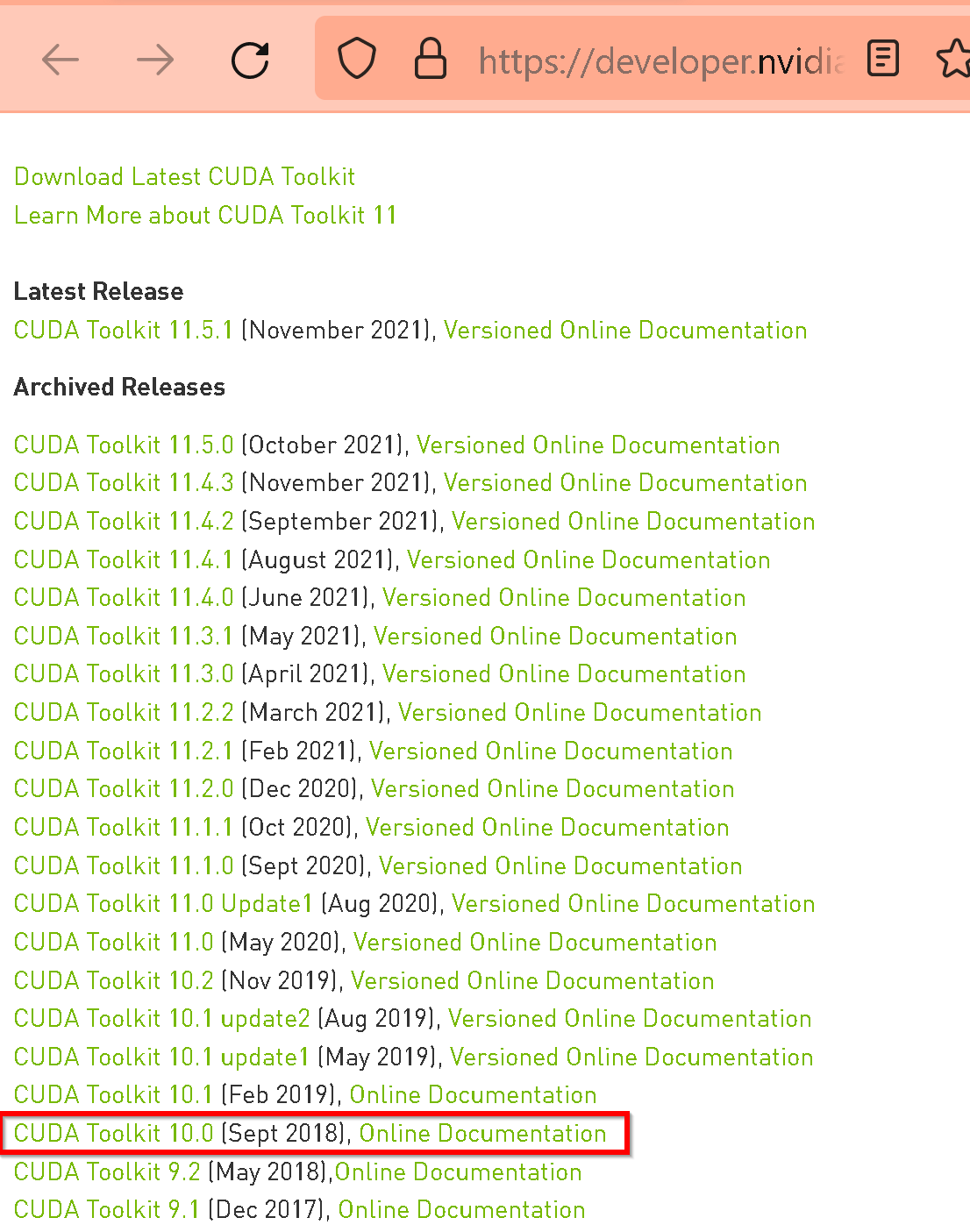
- 「Windows」,「10」,「exe [local]」を選ぶ.

- 「Base Installer」の右横の「Download」をクリックして,.exe ファイルをダウンロード
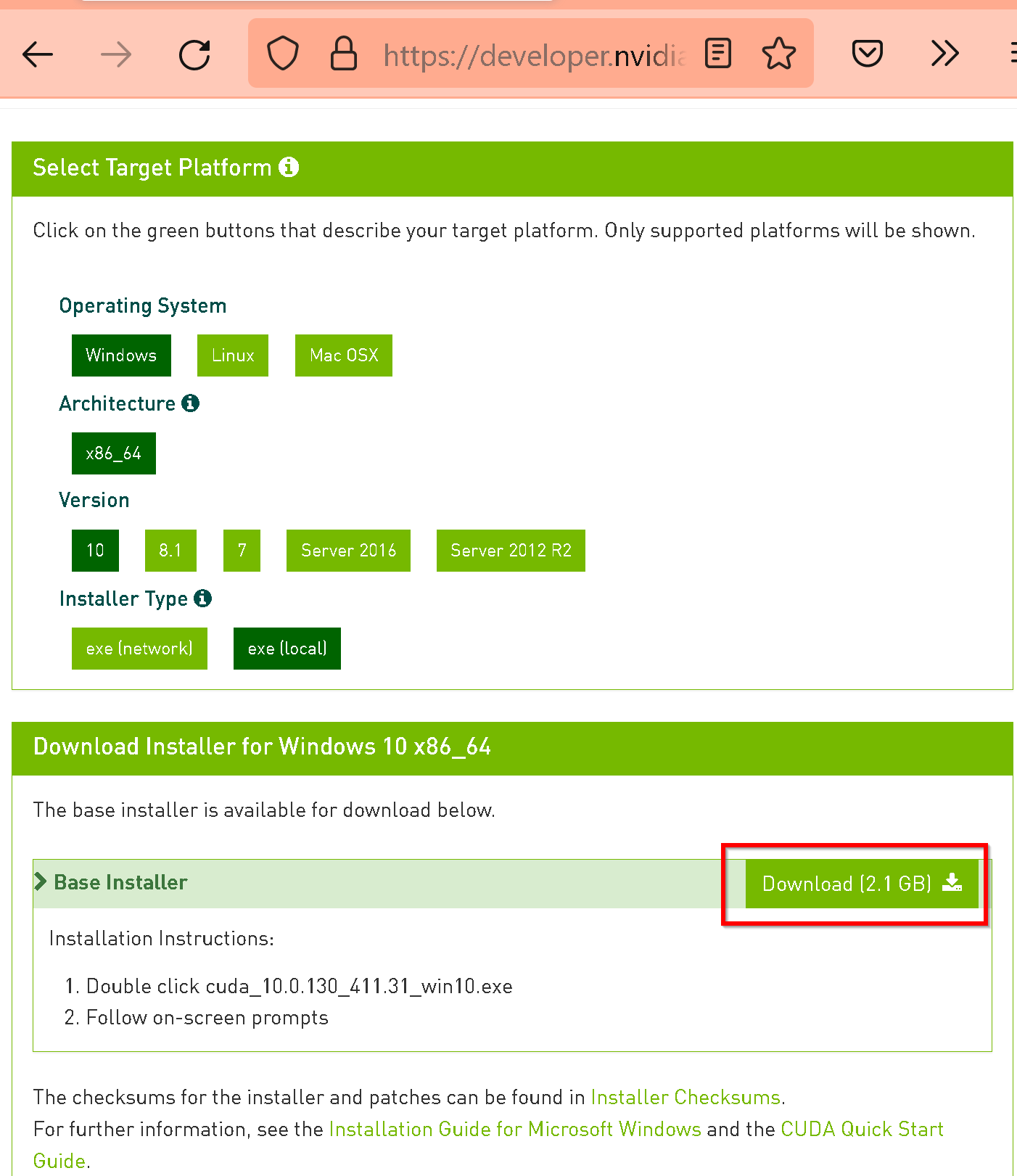
- exe ファイルのダウンロードが始まる
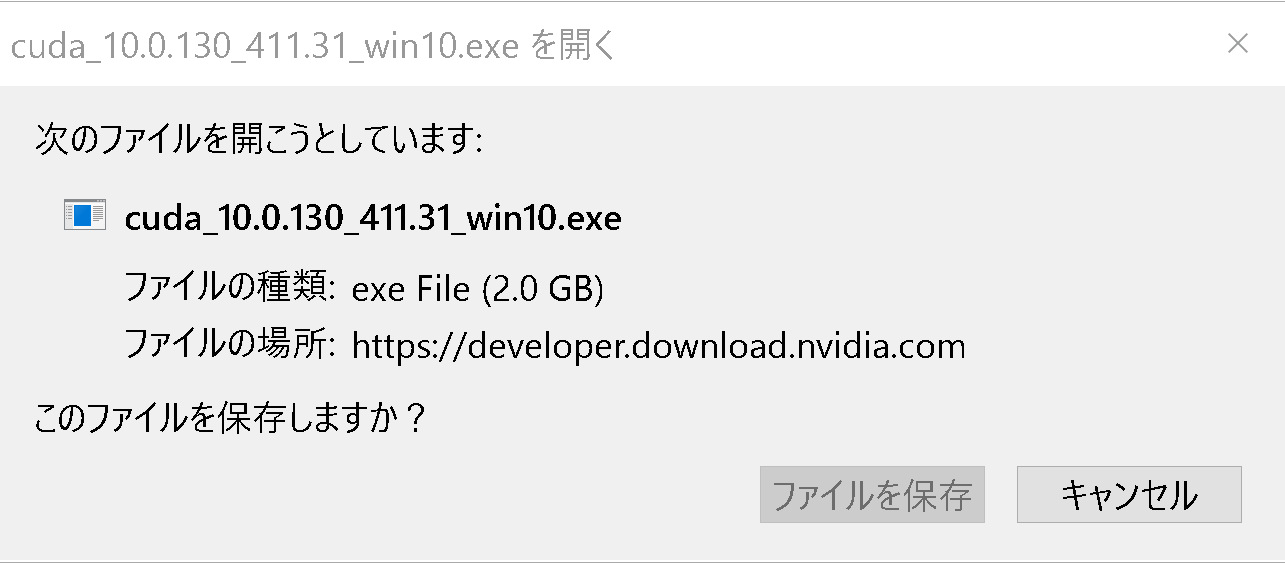
- ダウンロードした .exe ファイルを実行する.
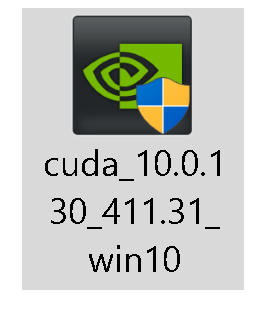
- 展開(解凍)先ディレクトリ(フォルダ)の指定.
既定(デフォルト)のままでよい.「OK」をクリック.
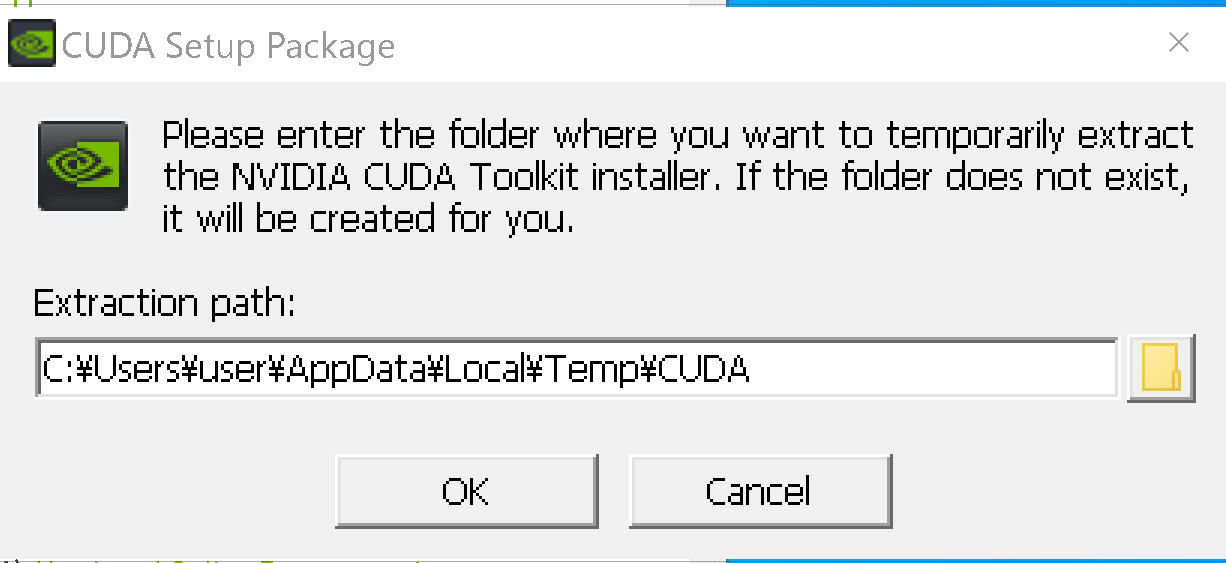
- 展開(解凍)が自動で行われるので,しばらく待つ.
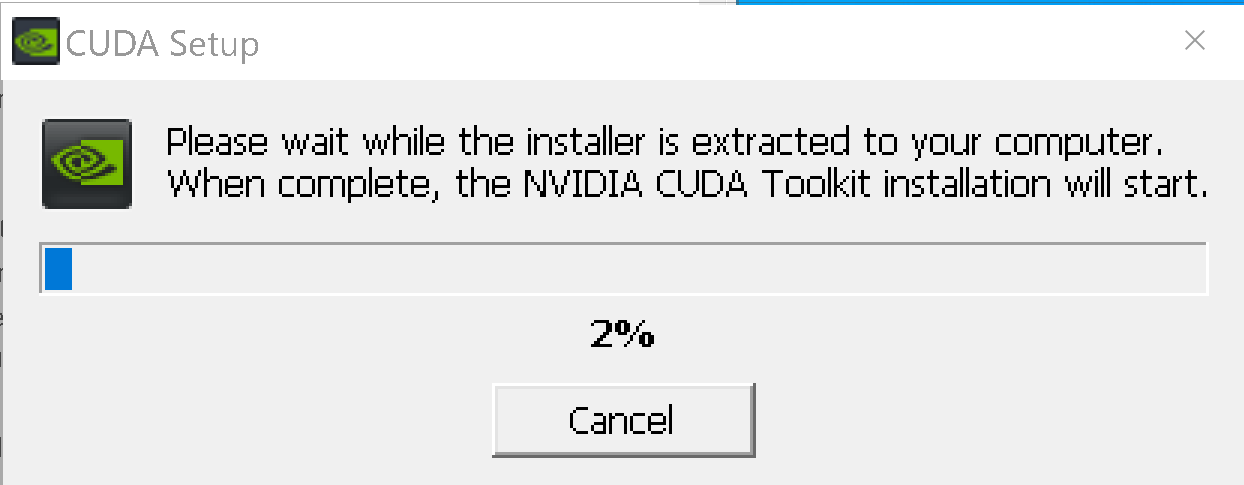
- ライセンス条項の確認.

- インストールオプションは,「カスタム(詳細)」を選び,「次へ」をクリック.
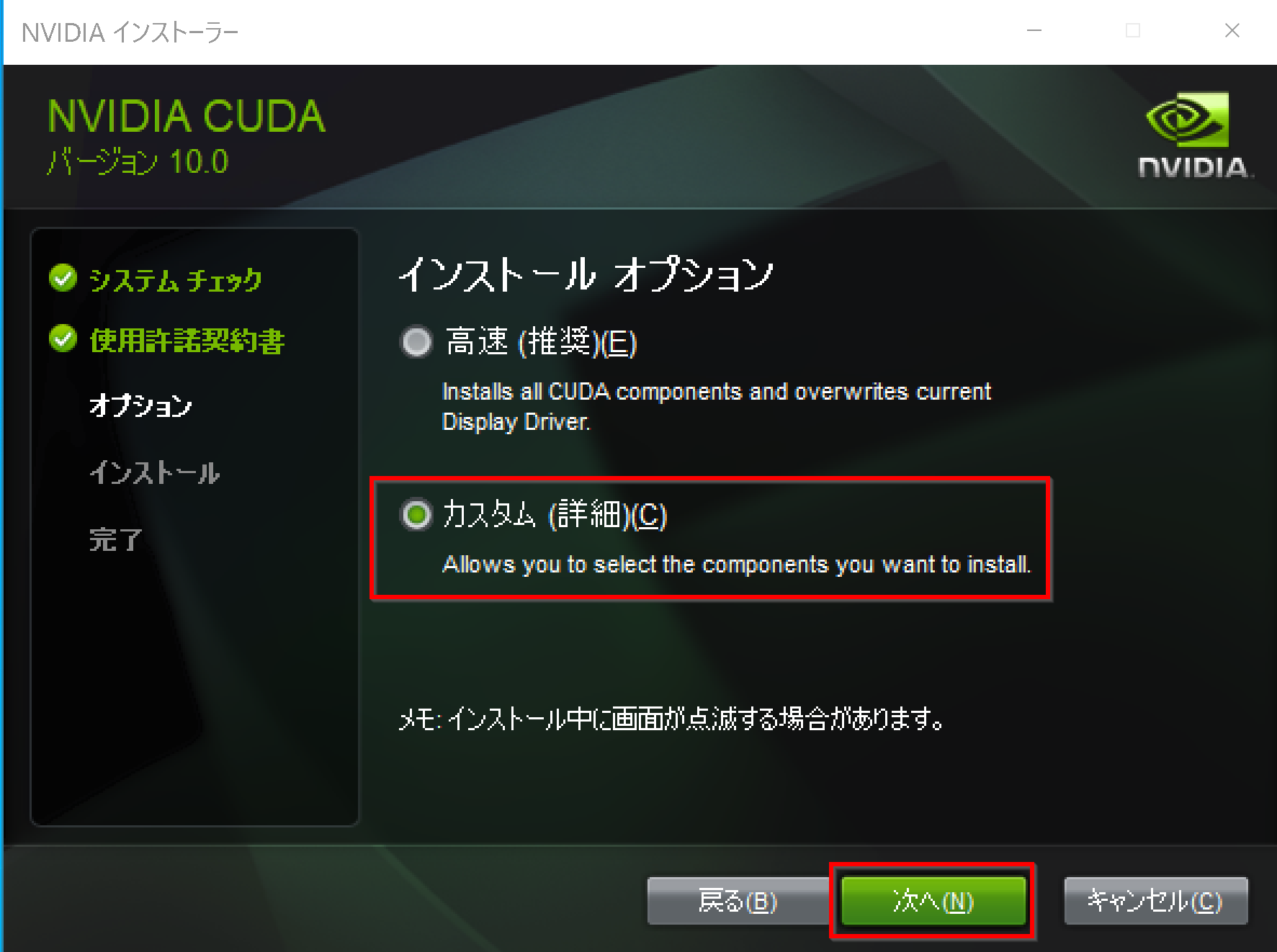
- コンポーネントを確認する.
「CUDA」にチェックする.その他は,必要なものがあればチェックする.「次へ」をクリック.
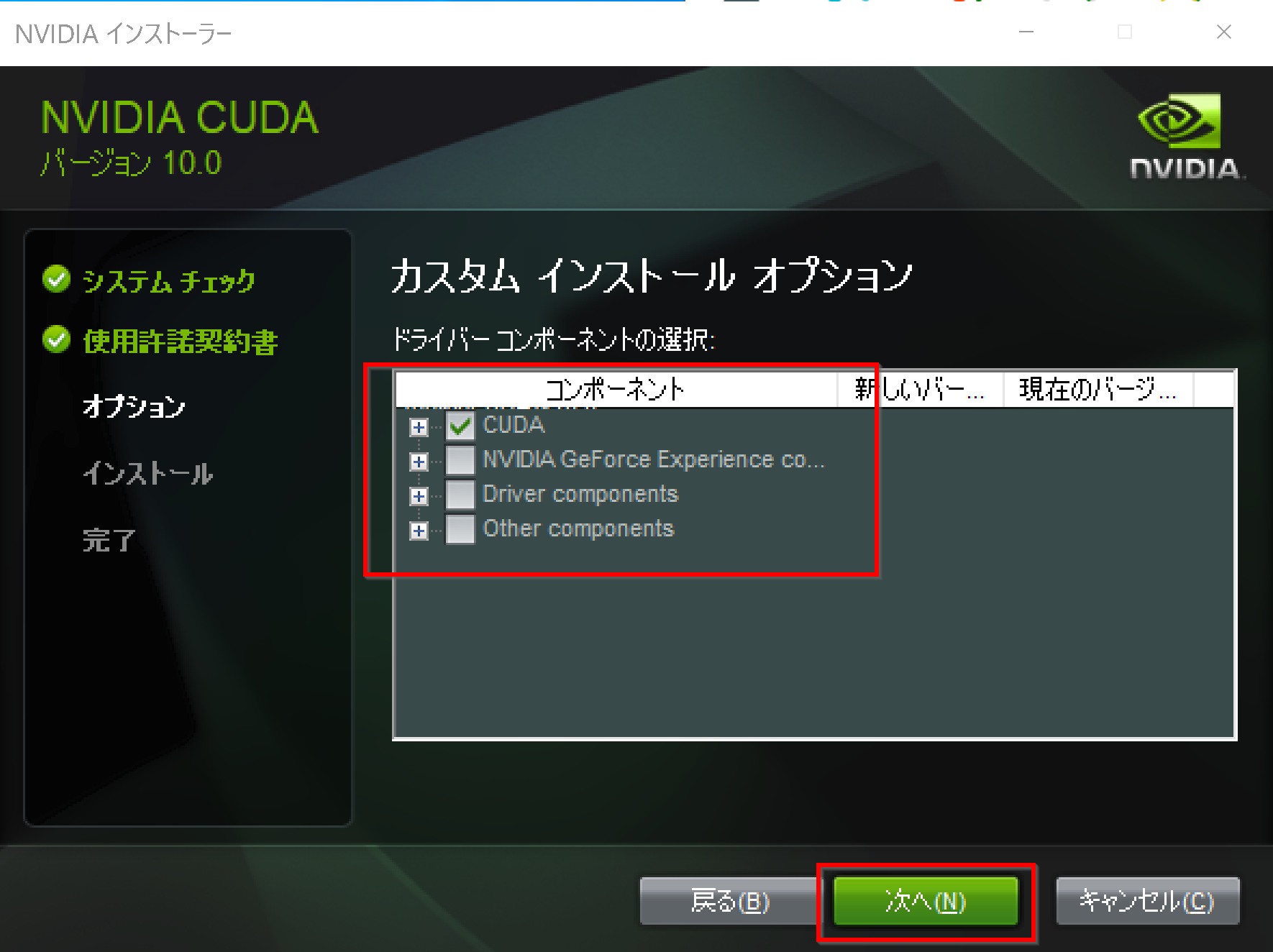
複数の版の NVIDIA CUDA ツールキットをインストールする場合には,古い版のNVIDIA CUDA ツールキットをインストールするときに「CUDA」だけを選ぶようにする.
- インストール場所の選択は,既定(デフォルト)のままでよい.「次へ」をクリック.
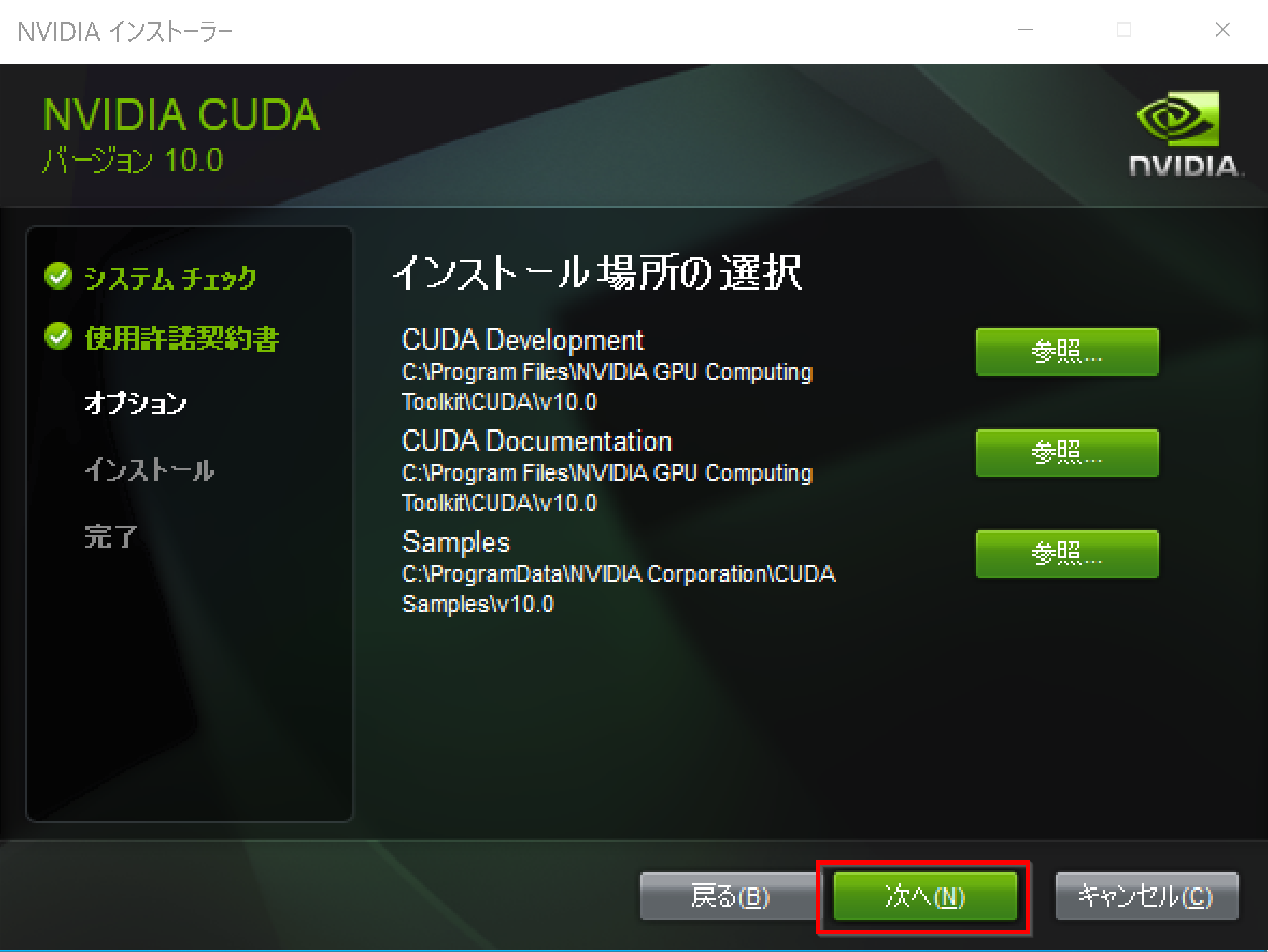
- Visual Studio Integration について表示された場合
表示されなくても問題はない.
表示された場合には,NVIDIA CUDA のインストールを中止して, Visual Studio Commnity 2017 のインストールを行う.
Visual Studio Commnity 2017 のインストールは, https://visualstudio.microsoft.com/ja/vs/older-downloads/ で「2017」を選び,「ダウンロード」をクリック. その後表示されるダウンロードの画面で, 「Visual Studio Commnity 2017」を選ぶ. インストール時には「C++ によるデスクトップ開発」をチェックしてインストールする.
- このとき,Windows セキュリティの画面が開くことがある.開いた場合には,「インストール」をクリック.
- インストールが始まるので,確認する.
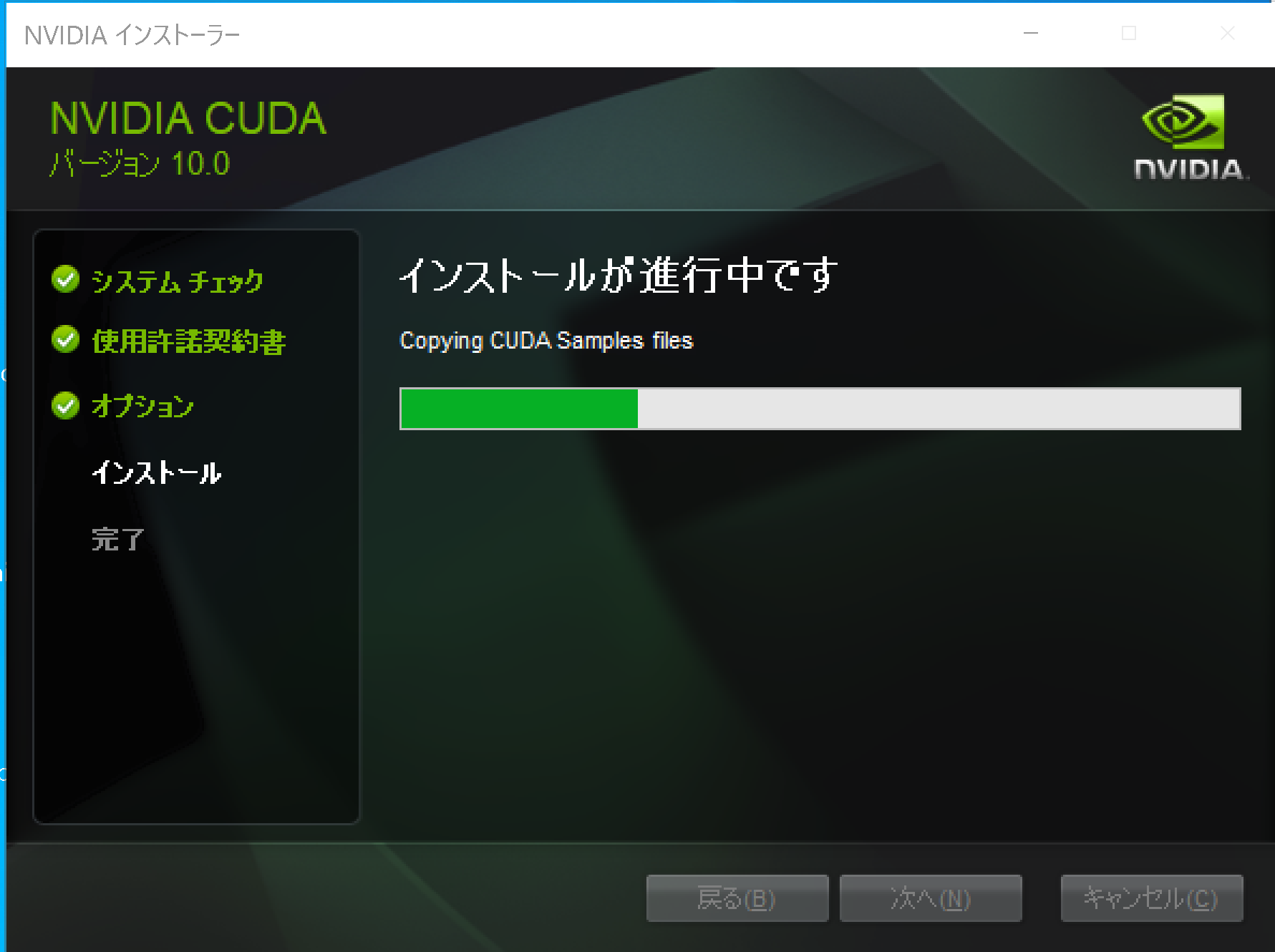
- このとき,グラフィックス・カードのドライバのインストールについての画面が表示される場合がある.「インストール」をクリックして,インストールを続行する.
- Visual Studio がインストール済みのときは,Nsight Visual Studio がインストールされたことが確認できる.確認したら「次へ」をクリック.
Visual Studio をインストールしていないときは,Nsight for Visual Studio はインストールされない.
- インストール終了の確認.「閉じる」をクリック.
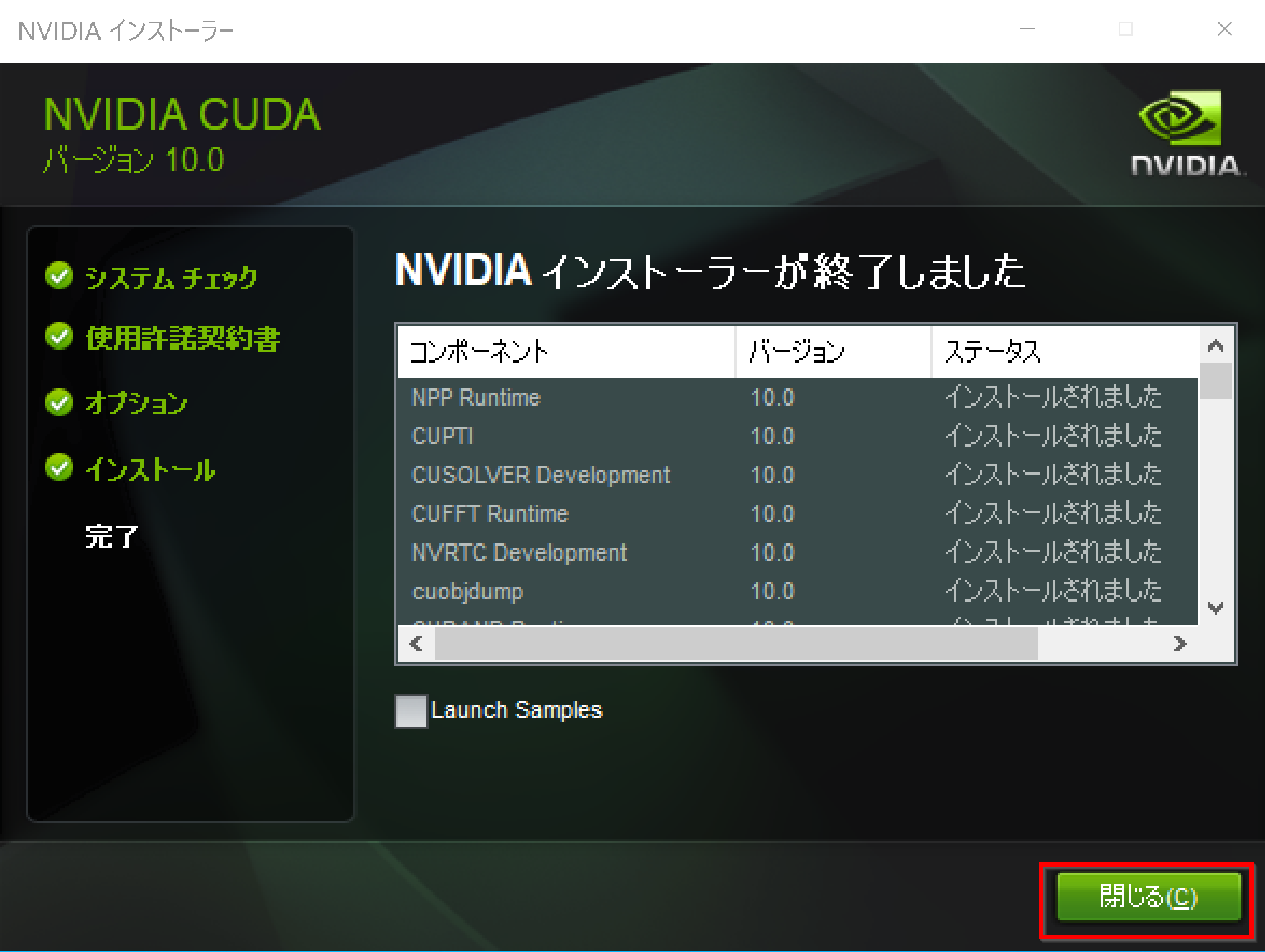
* 「コンピュータを再起動してください」と表示される場合がある.そのときは,再起動する.
- GeForce Experience が自動で開く場合がある
- 利用条件について表示されたときは、よく確認し、納得できる場合のみ同意・続行する
- リリースハイライトが表示される場合がある.
リリースハイライトを確認したら,「x」をクリックして閉じる.
- このとき,最新版への更新が始まり,起動に時間がかかることがある.
そして「お使いのGPU向けの新しいドライバーが入手可能です」と表示されることがある.そのときは,新しいドライバをインストールする.
- NVIDIA cuDNN の公式ページ(ダウンロードにはDeveloper Programへの登録が必要): https://developer.nvidia.com/cudnn
- NVIDIA Developer Program メンバーシップへの加入: cuDNNのダウンロードには無料のメンバーシップ登録が必要です。
NVIDIA Developer Program の公式ページ: https://developer.nvidia.com/developer-program
- 互換バージョンの選択とダウンロード: インストール済みのCUDAツールキットのバージョン (今回は11.x) に適合するcuDNNのバージョン (今回はv8.9.7) を選択し、Windows用のzipファイルをダウンロードします。
- ファイルの展開と配置: ダウンロードしたzipファイルを展開(解凍)し、中のファイル(
bin,include,libフォルダ内)を、CUDAツールキットのインストールディレクトリにコピーします。 - (オプション) 環境変数の設定: 必要に応じてシステム環境変数
CUDNN_PATHを設定します。 - (必要に応じて) ZLIB DLL のインストール:
zlibwapi.dllが見つからないエラーが発生する場合にインストールします。 - 動作確認: cuDNNライブラリ (
cudnn64_*.dll) にパスが通っているか確認します。 - NVIDIA cuDNN のウェブページを開く
- ダウンロードしたいので,cuDNNのところにある「Download cuDNN」をクリック.

- NVIDIA Developer Program メンバーシップに入る
NVIDIA cuDNN のダウンロードのため.
「Join now」をクリック.その後,画面の指示に従う. 利用者本人が,電子メールアドレス,表示名,パスワード,生年月日を登録.利用条件等に合意.

- ログインする

- 調査の画面が出たときは,調査に応じる
- ライセンス条項の確認

- 「Archived cuDNN Releases」をクリック

- ダウンロードしたいバージョンを選ぶ
ここでは「cuDNN v 7.6.5, for CUDA 10.0」を選んでいる.
このとき,画面の「for CUDA ...」のところを確認し,使用するNVIDIA CUDA のバージョンに合うものを選ぶこと.
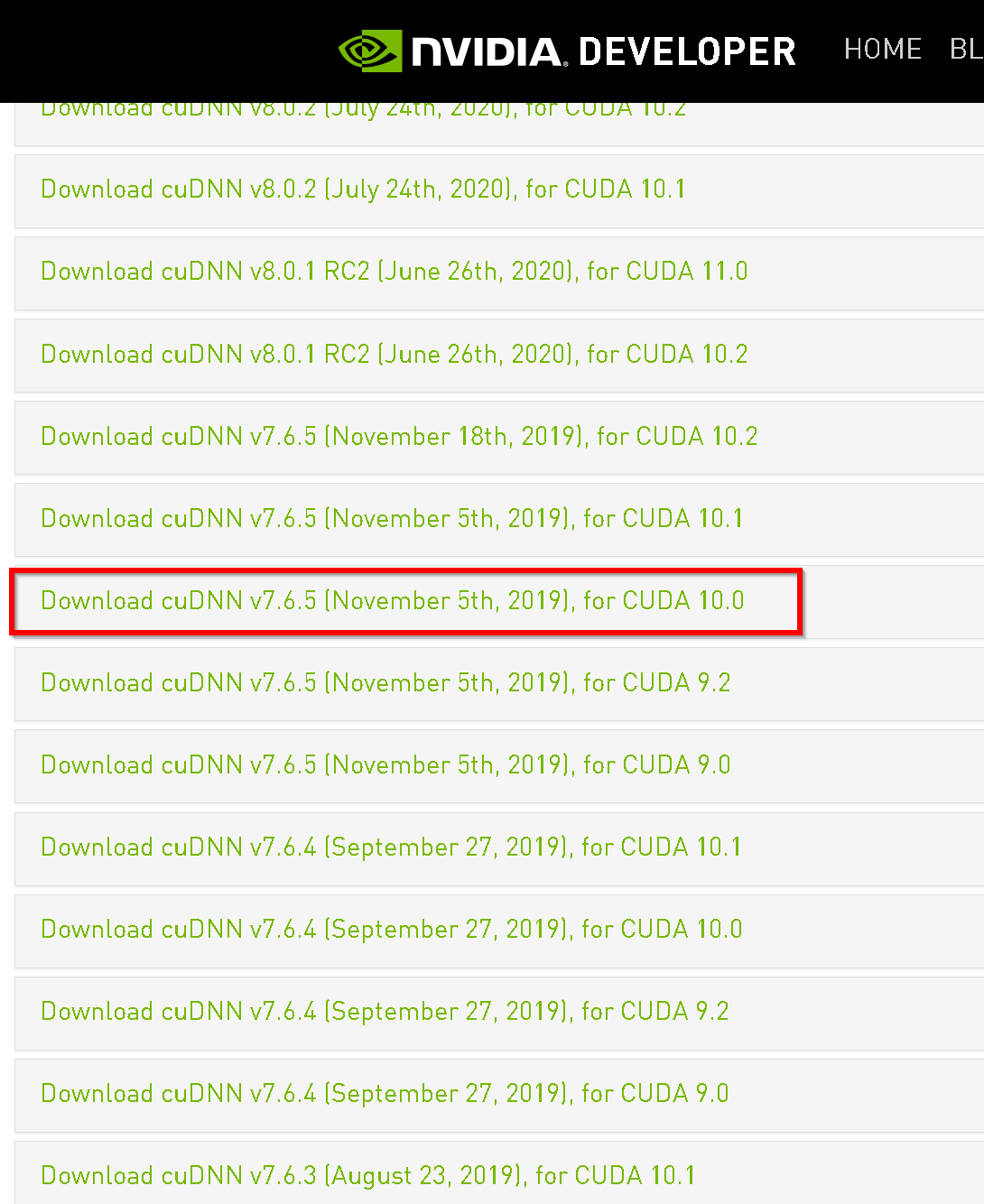
- Windows にインストールするので Windows 版を選ぶ
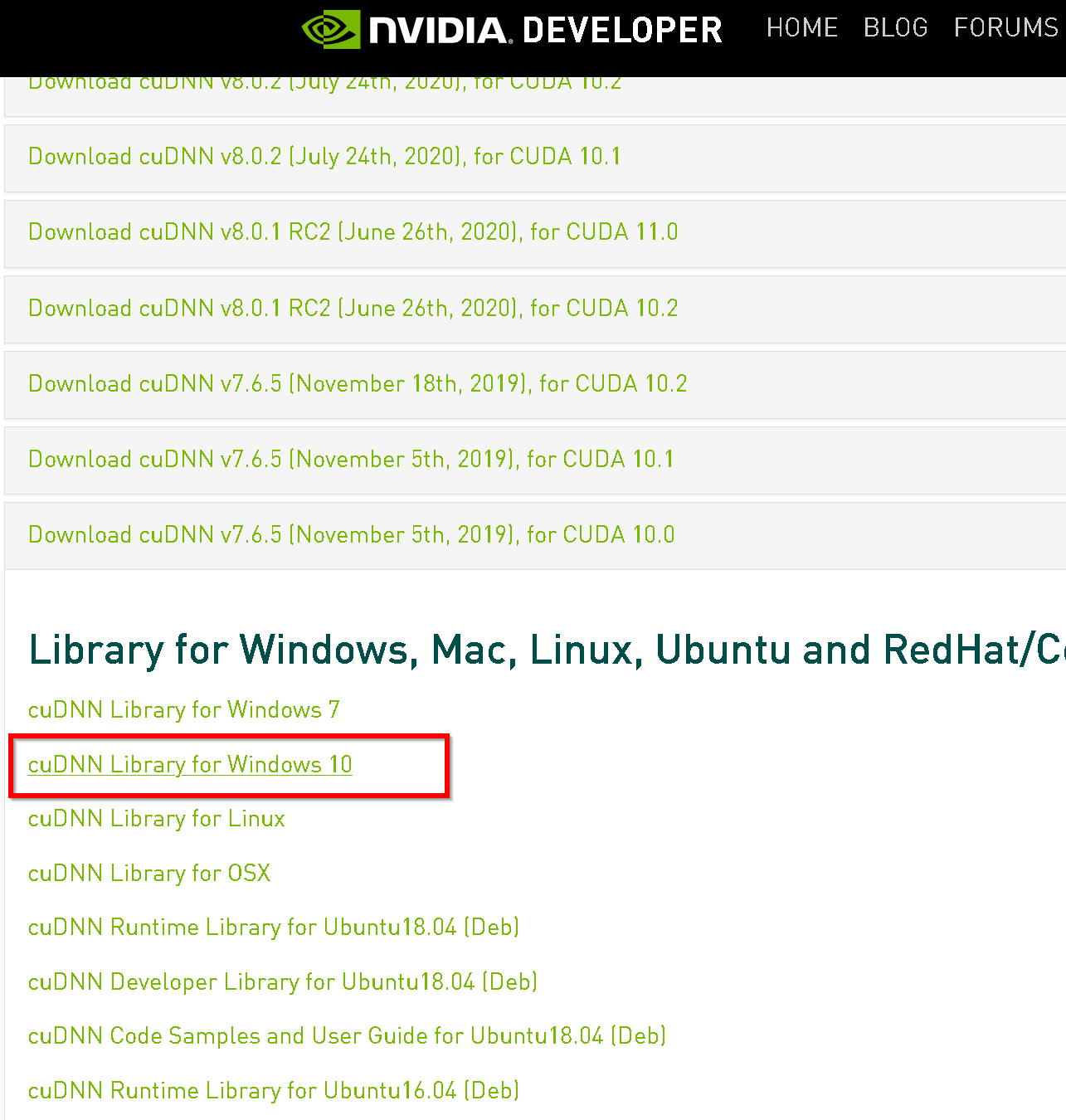
- ダウンロードが始まる.
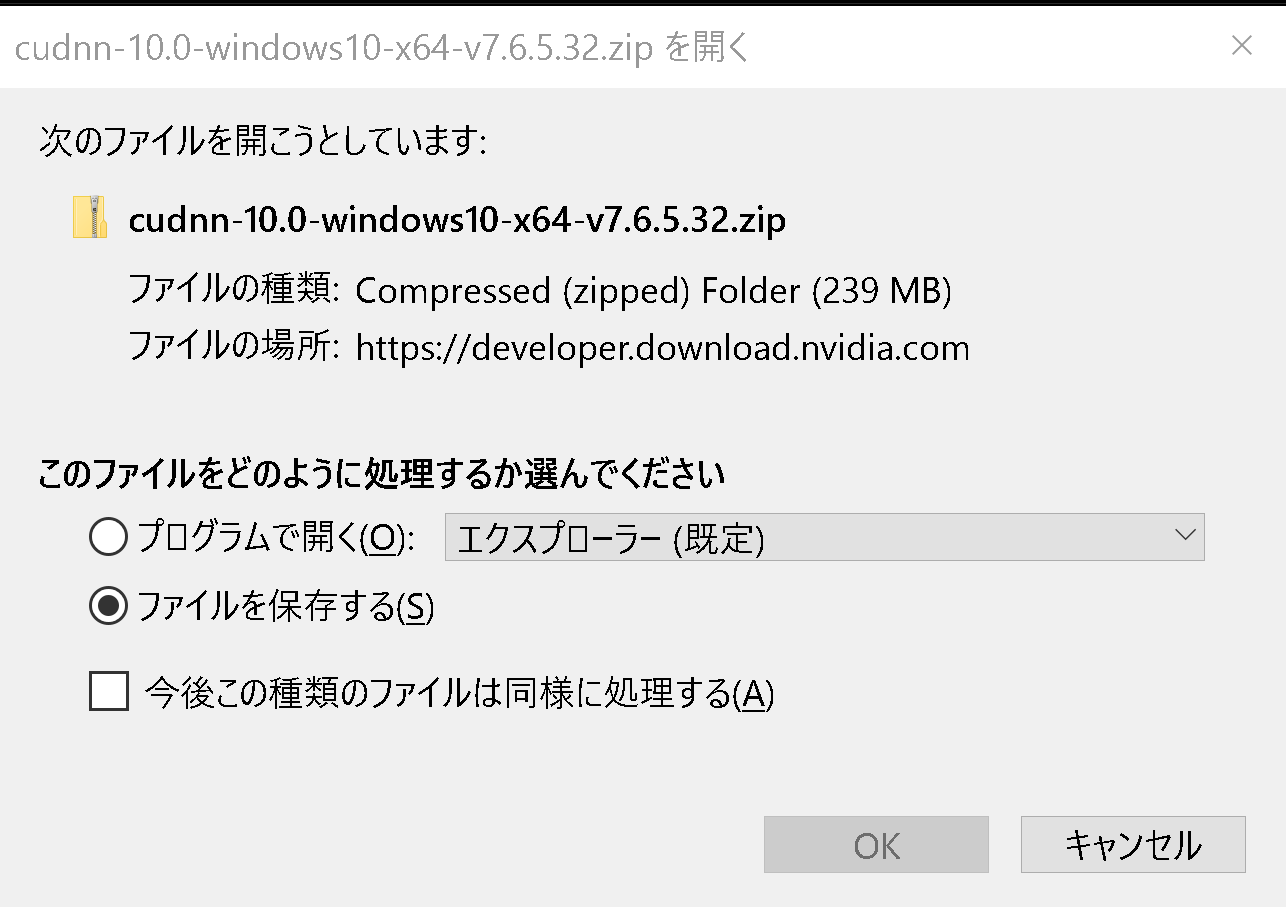
- ダウンロードした .zip ファイルを展開(解凍)する.展開の結果 cuda という名前のディレクトリができる.その中のサブディレクトリを確認しておく.

- NVIDIA CUDA ツールキットをインストールしたディレクトリは,「C:\Program Files\NVIDIA GPU Computing Toolkit\CUDA\v10.0」
のようになっている.確認する.
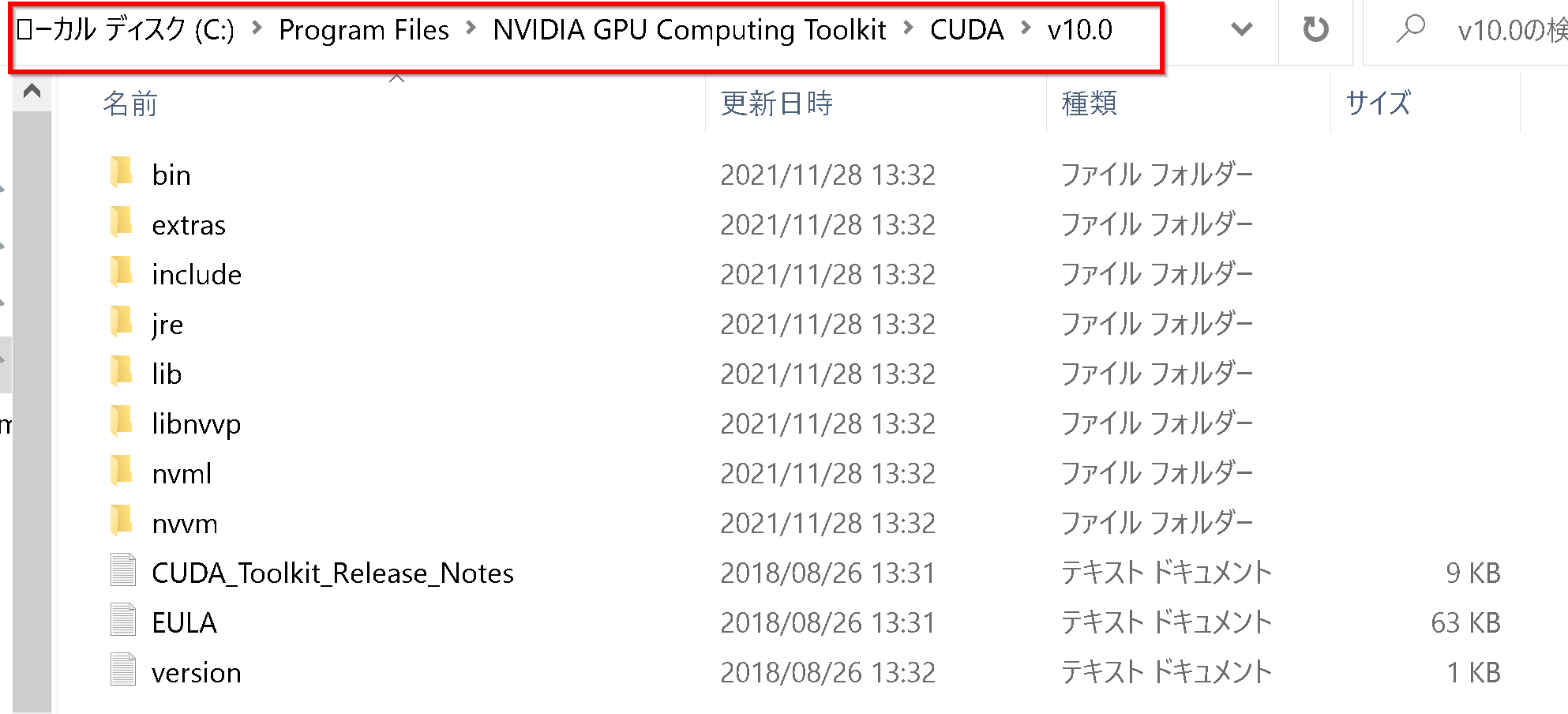
- 確認したら,
さきほど展開してできたディレクトリcuda の下にあるすべてのファイルとディレクトリを,NVIDIA CUDA ツールキットをインストールしたディレクトリにコピーする
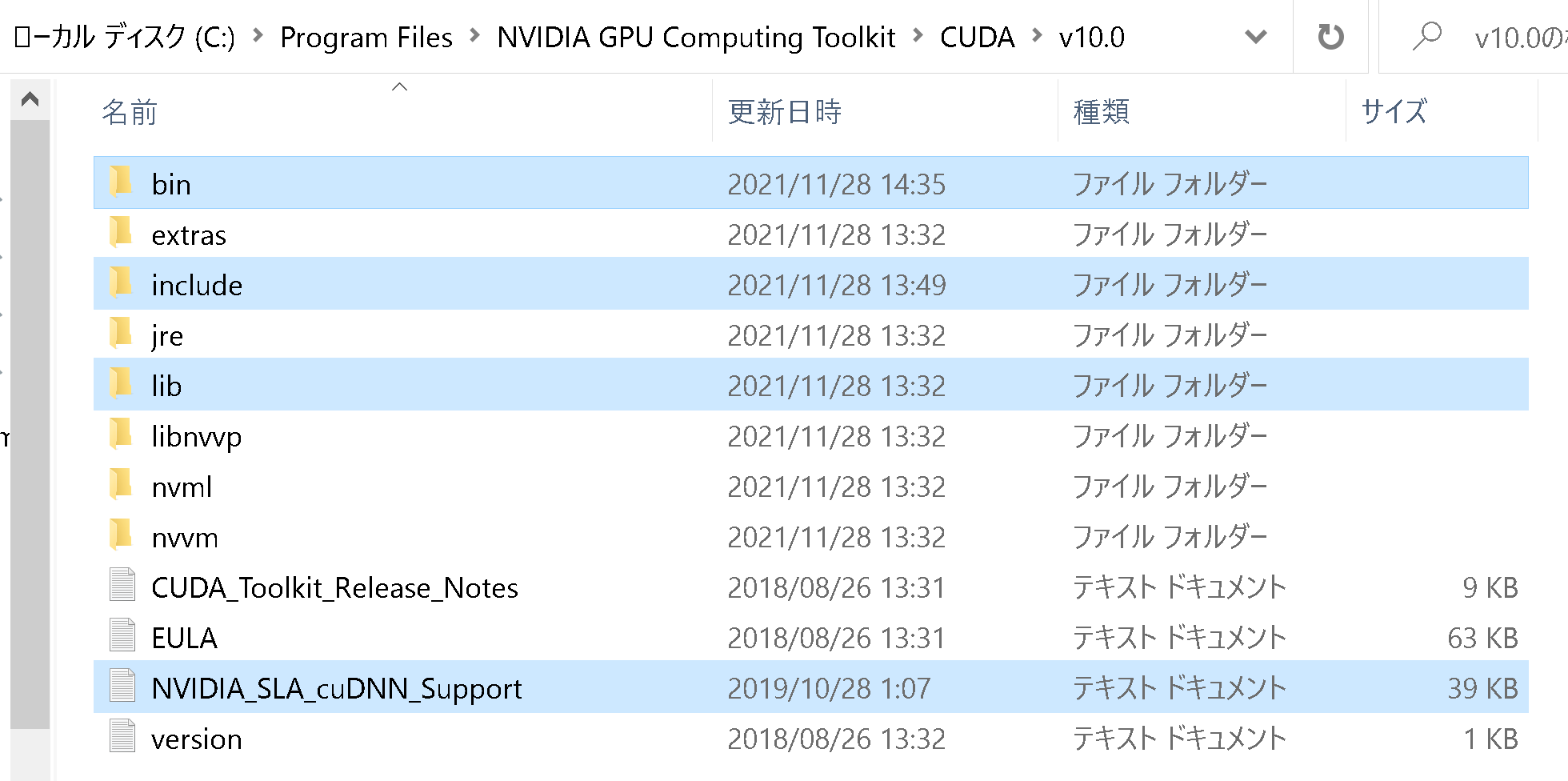
- すでに,c:\Program Files\NVIDIA GPU Computing Toolkit\CUDA\v10.0\bin には,パスが通っている.
- Windows の システム環境変数 CUDNN_PATH に,c:\Program Files\NVIDIA GPU Computing Toolkit\CUDA\v10.0 を設定
Windows で,管理者権限でコマンドプロンプトを起動(手順:Windowsキーまたはスタートメニュー >
cmdと入力 > 右クリック > 「管理者として実行」)。次のコマンドを実行
powershell -command "[System.Environment]::SetEnvironmentVariable(\"CUDNN_PATH\", \"c:\Program Files\NVIDIA GPU Computing Toolkit\CUDA\v10.0\", \"Machine\")"
- Windows の システム環境変数 Pathに,次が含まれていることを確認
C:\Program Files\NVIDIA GPU Computing Toolkit\CUDA\v10.0\bin

- Python の URL を開く
- Windows 版の Python 3.7 をダウンロード
ページの上の方にある「Downloads」をクリック,「Downloads」の下にメニューが出るので,その中の「Windows」をクリック.
そして,Python 3.7.x (x は数字)を探す.
そして,Windows の 64ビット版のインストーラをダウンロードしたいので,「Windows x86-64 executable installer」を選ぶ
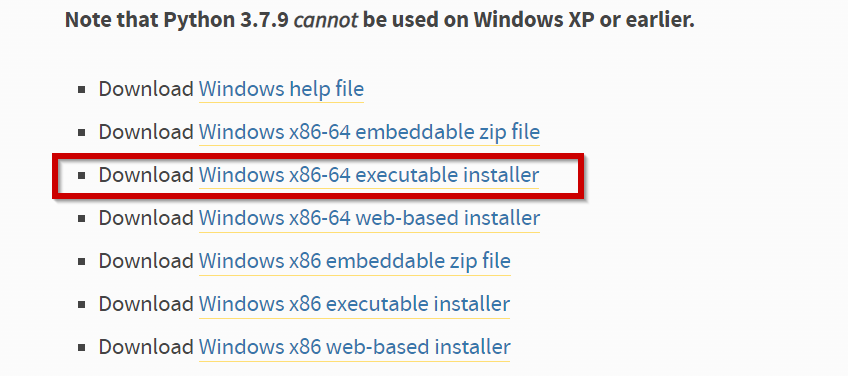
- インストール時の設定
- いまダウンロードした .exe ファイルを右クリック,
右クリックメニューで「管理者として実行」を選ぶ.
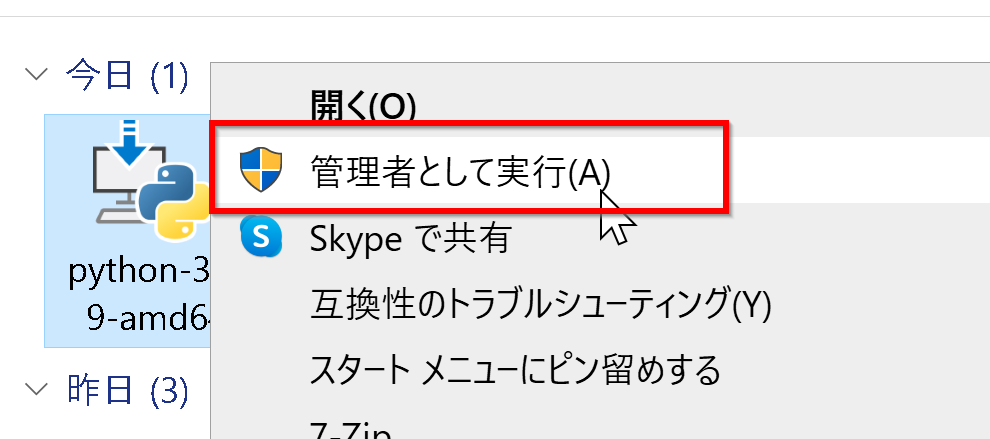
-
Python ランチャーをインストールするために,「Install launcher for all users (recommended)」をチェック.
* すでに Python ランチャーをインストール済みのときは, 「Install launcher for all users (recommended)」がチェックできないようになっている場合がある.そのときは,チェックせずに進む.
- 「Add Python 3.7 to PATH」をチェック.
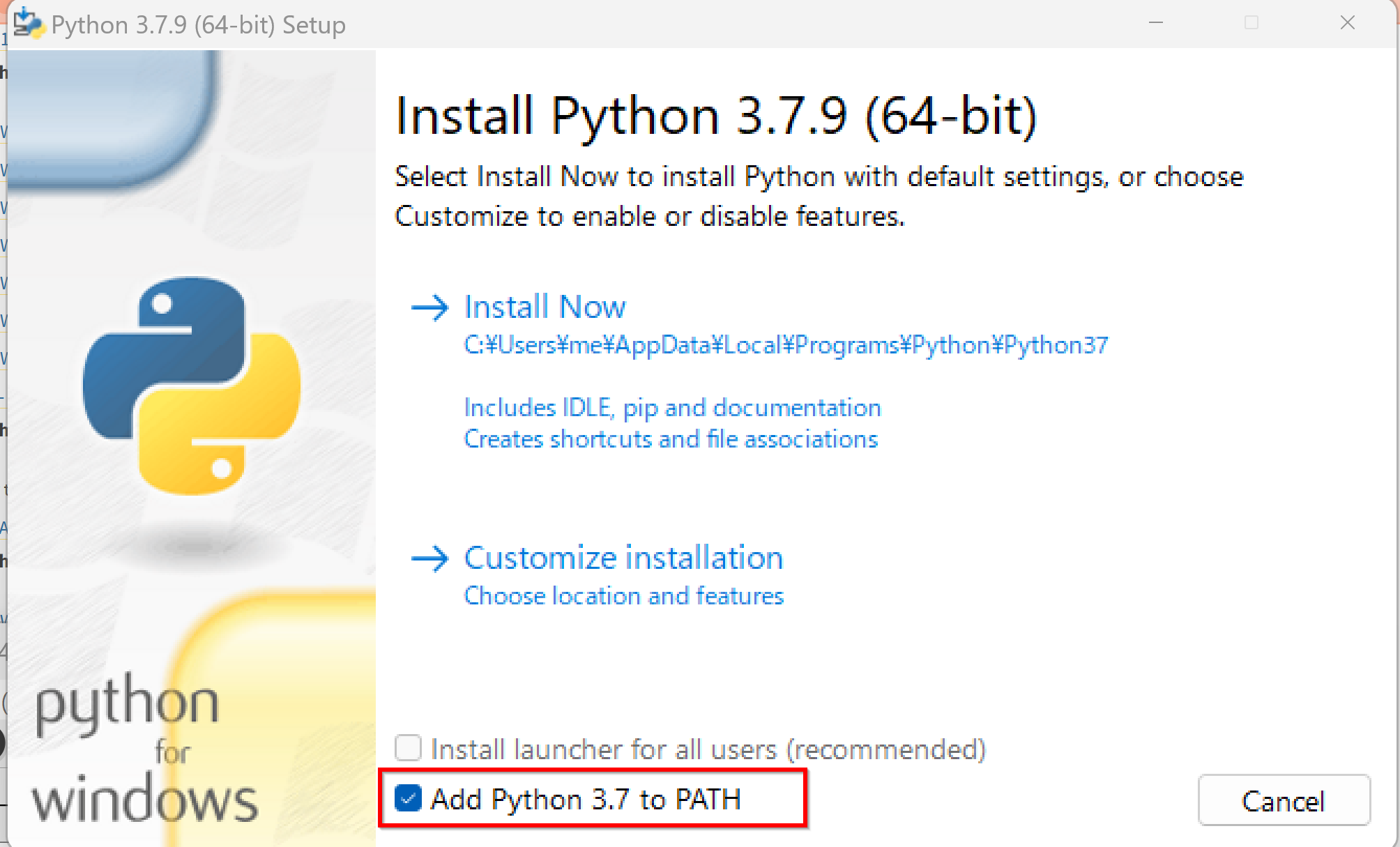
- 「Customize installation」をクリック.
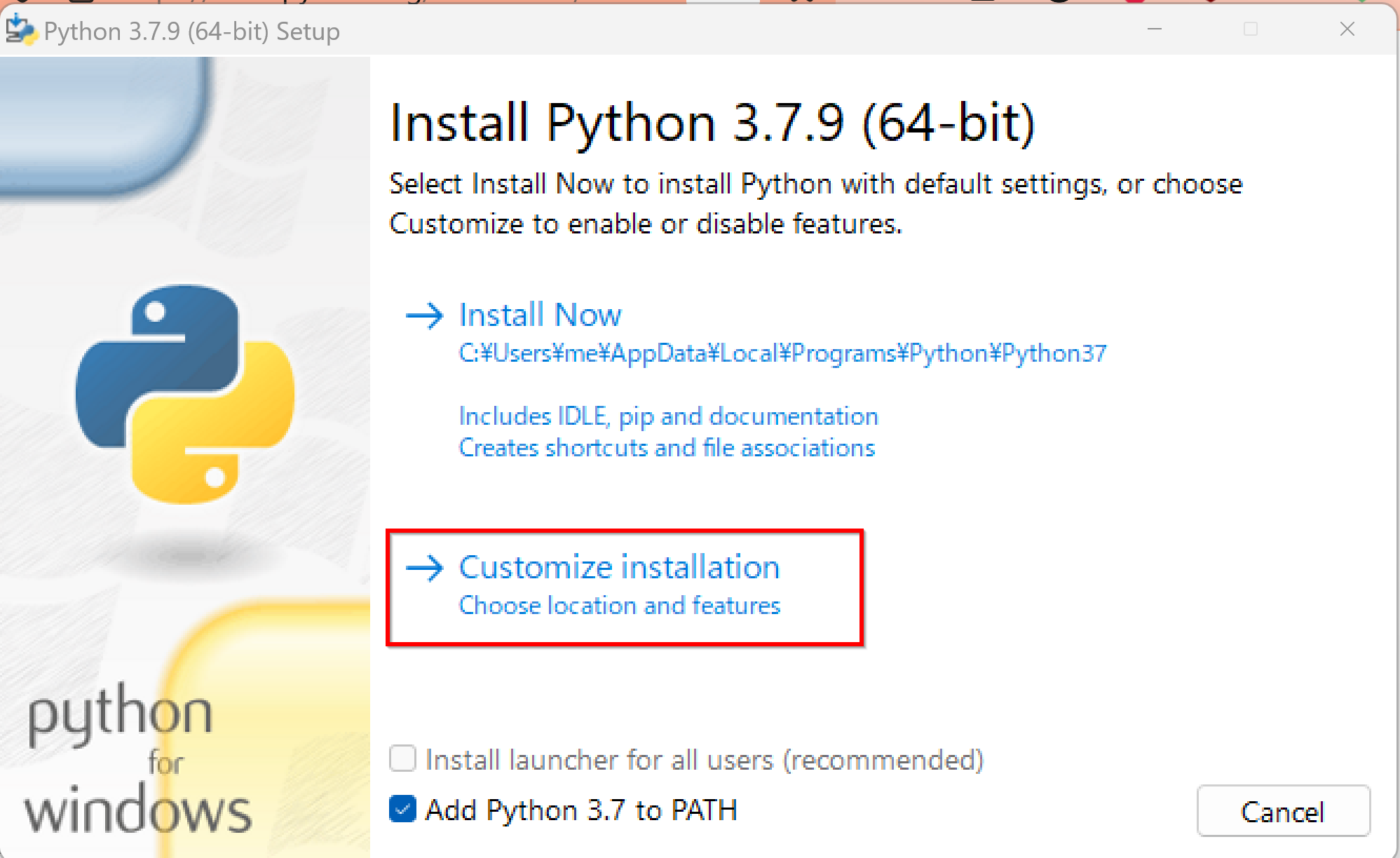
- オプションの機能 (Optional Features)は,既定(デフォルト)のままでよい.
「Next」をクリック
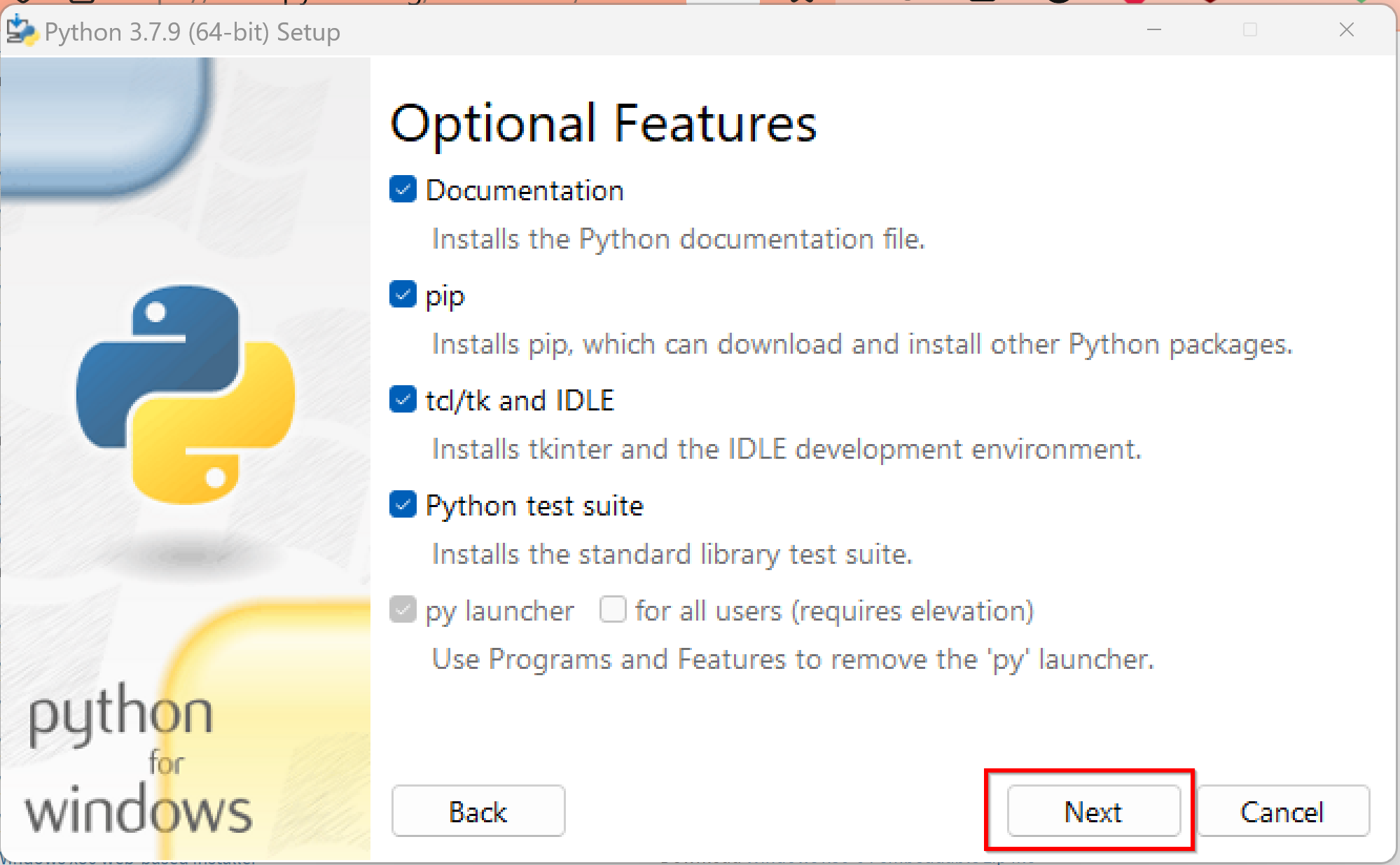
- 「Install for all users」を選ぶ.
Python のインストールディレクトリは,「C:\Program Files\Python37」のように自動設定されることを確認.
「Install」をクリック
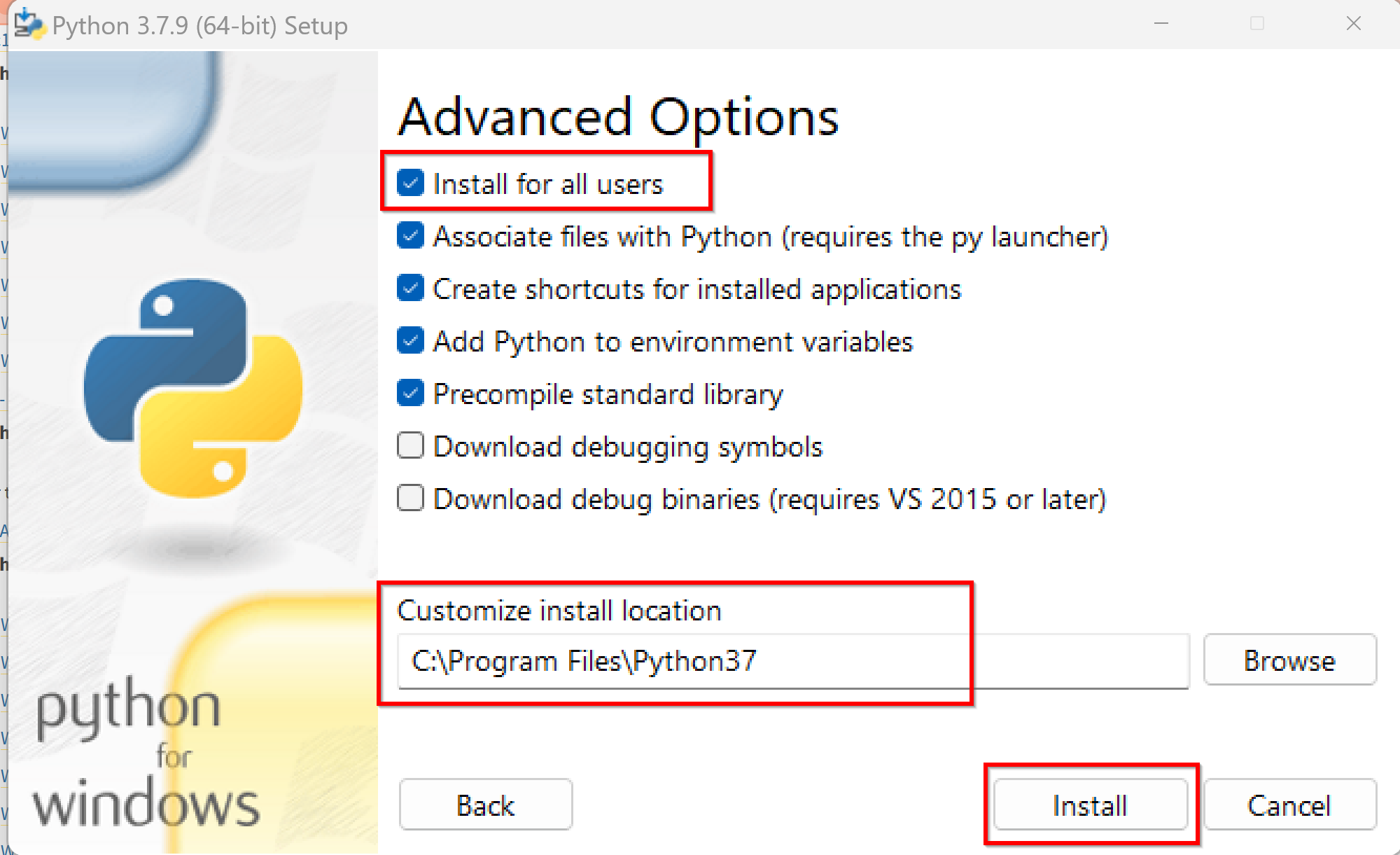
- 「Disable path length limit」が表示される場合がある.クリックして,パス長の制限を解除する

- インストールが終了したら,「Close」をクリック
- いまダウンロードした .exe ファイルを右クリック,
右クリックメニューで「管理者として実行」を選ぶ.
- インストールのあと,Windows のスタートメニューに「Python 3.7」が増えていることを確認.
- システムの環境変数 Path の確認のため,新しくコマンドプロンプトを開き,次のコマンドを実行する.
py とpip にパスが通っていることの確認である.
where py where pip
where py では「C:\Windows\py.exe」 が表示され, where pip では「C:\Program Files\Python37\Scripts\pip.exe」 が表示されることを確認.
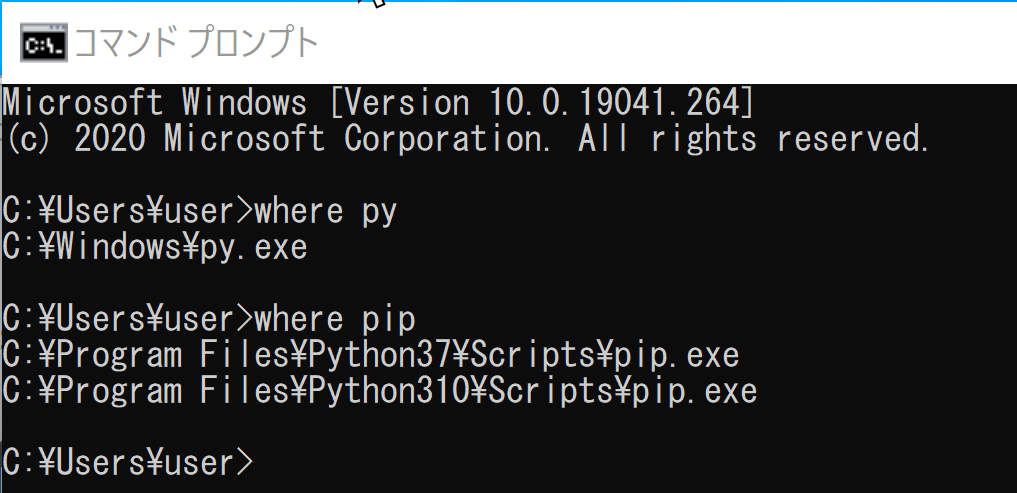
- Windows で,管理者権限でコマンドプロンプトを起動(手順:Windowsキーまたはスタートメニュー >
cmdと入力 > 右クリック > 「管理者として実行」)。 - 次のコマンドを実行する
Python の使用は「py -3.7」で行う.
py -3.7 -m pip install -U pip setuptools
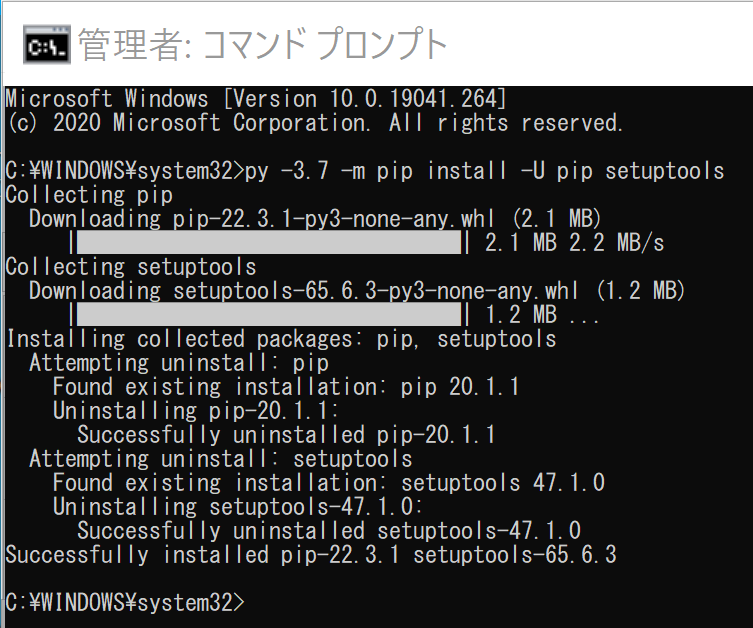
- Windows で,管理者権限でコマンドプロンプトを起動(手順:Windowsキーまたはスタートメニュー >
cmdと入力 > 右クリック > 「管理者として実行」)。 - venv を用いて,Python の仮想環境を作成
次のコマンドを実行する
py -3.7 -m pip install -U pip setuptools py -3.7 -m venv --system-site-packages C:\venv\py37
- Python の仮想環境の使用開始と,Python 開発環境のインストール
次のコマンドを実行する
Python の使用は「C:\venv\py37\Scripts\activate.bat」の後,「python」で行う.
C:\venv\py37\Scripts\activate.bat python -m pip install -U pip setuptools jupyterlab jupyter jupyter-console jupytext nteract_on_jupyter
- (再掲) NVIDIA グラフィックス・ボードの確認
インストールするドライバを選択するために、まずご使用のPCに搭載されているNVIDIAグラフィックス・ボードの種類を確認します。(確認済みであれば、この手順は不要です。) Windows のコマンドプロンプトで次のコマンドを実行します。
wmic path win32_VideoController get name
- NVIDIA ドライバのダウンロード
確認したグラフィックス・ボードのモデル名と、お使いのWindowsのバージョン(例: Windows 11, Windows 10 64-bit)に対応するドライバを、以下のNVIDIA公式サイトからダウンロードします.
https://www.nvidia.co.jp/Download/index.aspx?lang=jp
サイトの指示に従い、製品タイプ、製品シリーズ、製品ファミリー、OS、言語などを選択して検索し、適切なドライバ(通常は最新のGame Ready ドライバまたはStudio ドライバ)をダウンロードします。
- ドライバのインストール
ダウンロードしたインストーラー(.exeファイル)を実行し、画面の指示に従ってインストールを進めます。「カスタムインストール」を選択すると、インストールするコンポーネント(ドライバ本体、GeForce Experience、PhysXなど)を選ぶことができます。通常は「高速(推奨)」で問題ありません。
インストール完了後、システムの再起動を求められる場合があります。
- CUDA対応のNVIDIA GPUが必要.
そのために,NVIDIA グラフィックス・ボードを確認する. Windows で,NVIDIA グラフィックス・ボードの種類を調べたいときは, 次のコマンドを実行することにより調べることができる.
wmic path win32_VideoController get name
- NVIDIA ドライバのダウンロードとインストール
NVIDIA ドライバは,以下の NVIDIA 公式サイトからダウンロードできる. ダウンロードの際には,使用しているグラフィックス・ボードの型番とオペレーティングシステムを選択する.
- Windows では,インストール前に,Build Tools for Visual Studio もしくは Visual Studio をインストールしておくことが必要である.
- Windows では, NVIDIA CUDA ツールキットのインストール中は,なるべく他のウインドウはすべて閉じておくこと.
- NVIDIA CUDA ツールキットのインストールが終わったら,ユーザ環境変数 TEMP の設定を行う.
Windows のユーザ名が日本語のとき,nvcc がうまく動作しないエラーを回避するためである.
ユーザ環境変数 TEMP に「C:\TEMP」を設定するために, コマンドプロンプトで,次のコマンドを実行する.
mkdir C:\TEMP powershell -command "[System.Environment]::SetEnvironmentVariable(\"TEMP\", \"C:\TEMP\", \"User\")"
- NVIDIA CUDA ツールキットのアーカイブの公式ページ: https://developer.nvidia.com/cuda-toolkit-archive
- NVIDIA CUDA ツールキット の公式のドキュメント: https://docs.nvidia.com/cuda/cuda-installation-guide-linux/index.html
- NVIDIA CUDA ツールキットのインストールに関する,NVIDIA CUDA クイックスタートガイドの公式ページ: https://docs.nvidia.com/cuda/cuda-quick-start-guide/index.html
- NVIDIA CUDA ツールキットのアーカイブのページを開く
- NVIDIA CUDA ツールキットのバージョンを選ぶ
ここでは,NVIDIA CUDA ツールキットの10.0を選んでいる

- 「Windows」,「10」,「exe [local]」を選ぶ.

- 「Base Installer」の右横の「Download」をクリックして,.exe ファイルをダウンロード

- exe ファイルのダウンロードが始まる

- ダウンロードした .exe ファイルを実行する.

- 展開(解凍)先ディレクトリ(フォルダ)の指定.
既定(デフォルト)のままでよい.「OK」をクリック.

- 展開(解凍)が自動で行われるので,しばらく待つ.

- ライセンス条項の確認.

- インストールオプションは,「カスタム(詳細)」を選び,「次へ」をクリック.

- コンポーネントを確認する.
「CUDA」にチェックする.その他は,必要なものがあればチェックする.「次へ」をクリック.

複数の版の NVIDIA CUDA ツールキットをインストールする場合には,古い版のNVIDIA CUDA ツールキットをインストールするときに「CUDA」だけを選ぶようにする.
- インストール場所の選択は,既定(デフォルト)のままでよい.「次へ」をクリック.

- Visual Studio Integration について表示された場合
表示されなくても問題はない.
表示された場合には,NVIDIA CUDA のインストールを中止して, Visual Studio Commnity 2017 のインストールを行う.
Visual Studio Commnity 2017 のインストールは, https://visualstudio.microsoft.com/ja/vs/older-downloads/ で「2017」を選び,「ダウンロード」をクリック. その後表示されるダウンロードの画面で, 「Visual Studio Commnity 2017」を選ぶ. インストール時には「C++ によるデスクトップ開発」をチェックしてインストールする.
- このとき,Windows セキュリティの画面が開くことがある.開いた場合には,「インストール」をクリック.
- インストールが始まるので,確認する.

- このとき,グラフィックス・カードのドライバのインストールについての画面が表示される場合がある.「インストール」をクリックして,インストールを続行する.
- Visual Studio がインストール済みのときは,Nsight Visual Studio がインストールされたことが確認できる.確認したら「次へ」をクリック.
Visual Studio をインストールしていないときは,Nsight for Visual Studio はインストールされない.
- インストール終了の確認.「閉じる」をクリック.

* 「コンピュータを再起動してください」と表示される場合がある.そのときは,再起動する.
- GeForce Experience が自動で開く場合がある
- 利用条件について表示されたときは、よく確認し、納得できる場合のみ同意・続行する
- リリースハイライトが表示される場合がある.
リリースハイライトを確認したら,「x」をクリックして閉じる.
- このとき,最新版への更新が始まり,起動に時間がかかることがある.
そして「お使いのGPU向けの新しいドライバーが入手可能です」と表示されることがある.そのときは,新しいドライバをインストールする.
- NVIDIA cuDNN の公式ページ(ダウンロードにはDeveloper Programへの登録が必要): https://developer.nvidia.com/cudnn
- NVIDIA Developer Program メンバーシップへの加入: cuDNNのダウンロードには無料のメンバーシップ登録が必要です。
NVIDIA Developer Program の公式ページ: https://developer.nvidia.com/developer-program
- 互換バージョンの選択とダウンロード: インストール済みのCUDAツールキットのバージョン (今回は11.x) に適合するcuDNNのバージョン (今回はv8.9.7) を選択し、Windows用のzipファイルをダウンロードします。
- ファイルの展開と配置: ダウンロードしたzipファイルを展開(解凍)し、中のファイル(
bin,include,libフォルダ内)を、CUDAツールキットのインストールディレクトリにコピーします。 - (オプション) 環境変数の設定: 必要に応じてシステム環境変数
CUDNN_PATHを設定します。 - (必要に応じて) ZLIB DLL のインストール:
zlibwapi.dllが見つからないエラーが発生する場合にインストールします。 - 動作確認: cuDNNライブラリ (
cudnn64_*.dll) にパスが通っているか確認します。 - NVIDIA cuDNN のウェブページを開く
- ダウンロードしたいので,cuDNNのところにある「Download cuDNN」をクリック.

- NVIDIA Developer Program メンバーシップに入る
NVIDIA cuDNN のダウンロードのため.
「Join now」をクリック.その後,画面の指示に従う. 利用者本人が,電子メールアドレス,表示名,パスワード,生年月日を登録.利用条件等に合意.

- ログインする

- 調査の画面が出たときは,調査に応じる
- ライセンス条項の確認

- 「Archived cuDNN Releases」をクリック

- ダウンロードしたいバージョンを選ぶ
ここでは「cuDNN v 7.6.5, for CUDA 10.0」を選んでいる.
このとき,画面の「for CUDA ...」のところを確認し,使用するNVIDIA CUDA のバージョンに合うものを選ぶこと.

- Windows にインストールするので Windows 版を選ぶ

- ダウンロードが始まる.

- ダウンロードした .zip ファイルを展開(解凍)する.展開の結果 cuda という名前のディレクトリができる.その中のサブディレクトリを確認しておく.

- NVIDIA CUDA ツールキットをインストールしたディレクトリは,「C:\Program Files\NVIDIA GPU Computing Toolkit\CUDA\v10.0」
のようになっている.確認する.

- 確認したら,
さきほど展開してできたディレクトリcuda の下にあるすべてのファイルとディレクトリを,NVIDIA CUDA ツールキットをインストールしたディレクトリにコピーする

- すでに,c:\Program Files\NVIDIA GPU Computing Toolkit\CUDA\v10.0\bin には,パスが通っている.
- Windows の システム環境変数 CUDNN_PATH に,c:\Program Files\NVIDIA GPU Computing Toolkit\CUDA\v10.0 を設定
Windows で,管理者権限でコマンドプロンプトを起動(手順:Windowsキーまたはスタートメニュー >
cmdと入力 > 右クリック > 「管理者として実行」)。次のコマンドを実行
powershell -command "[System.Environment]::SetEnvironmentVariable(\"CUDNN_PATH\", \"c:\Program Files\NVIDIA GPU Computing Toolkit\CUDA\v10.0\", \"Machine\")"
- Windows の システム環境変数 Pathに,次が含まれていることを確認
C:\Program Files\NVIDIA GPU Computing Toolkit\CUDA\v10.0\bin

- Windows で,コマンドプロンプトを管理者として実行.
- DeepGaze のインストールディレクトリを空にしておく
cd /d c:%HOMEPATH% rmdir /s /q deepgaze
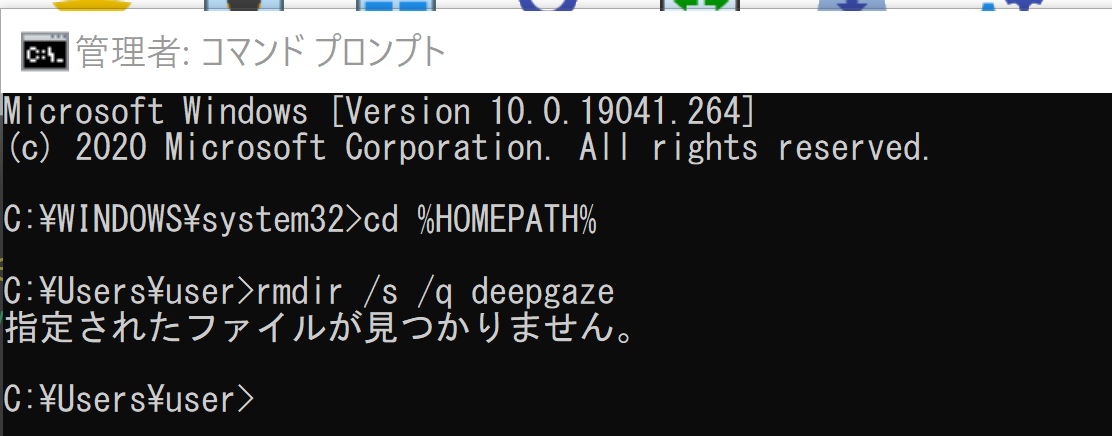
- DeepGaze のインストール
git clone https://github.com/mpatacchiola/deepgaze cd deepgaze py -3.7 setup.py build py -3.7 setup.py install
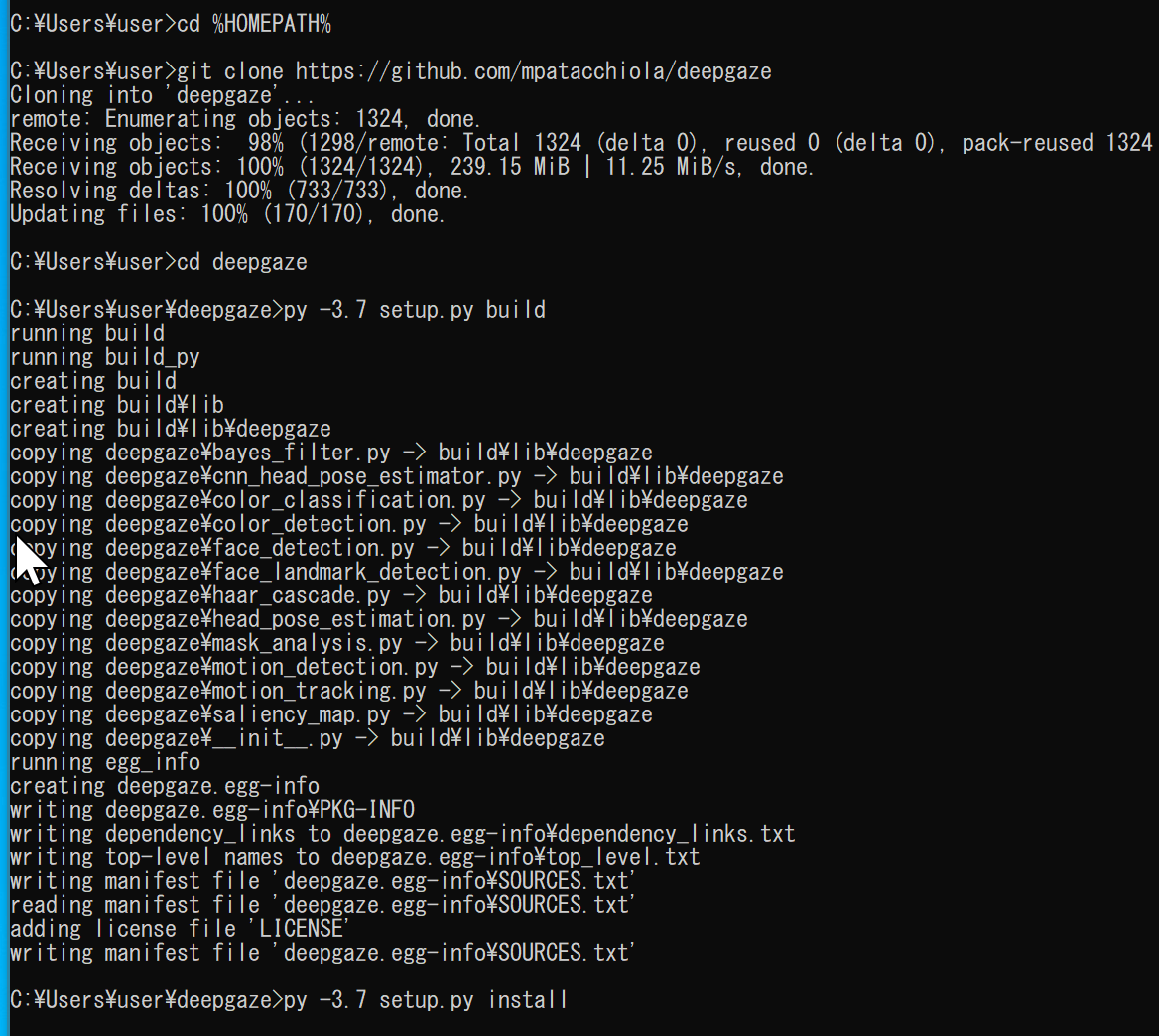
(以下省略) - 結果の確認
エラーメッセージが出ていないこと.
- ここで使用する mp4 形式動画ファイル: sample1.mp4
- ここで使用する顔写真: 126.png, 127.png

- Windows では,コマンドプロンプトを実行.
- 作業用のディレクトリ(フォルダ)として,c:\imageを作り,
sample1.mp4 を,c:\image の下にダウンロード
mkdir c:\image cd c:\image curl -O https://www.kkaneko.jp/sample/face/sample1.mp4
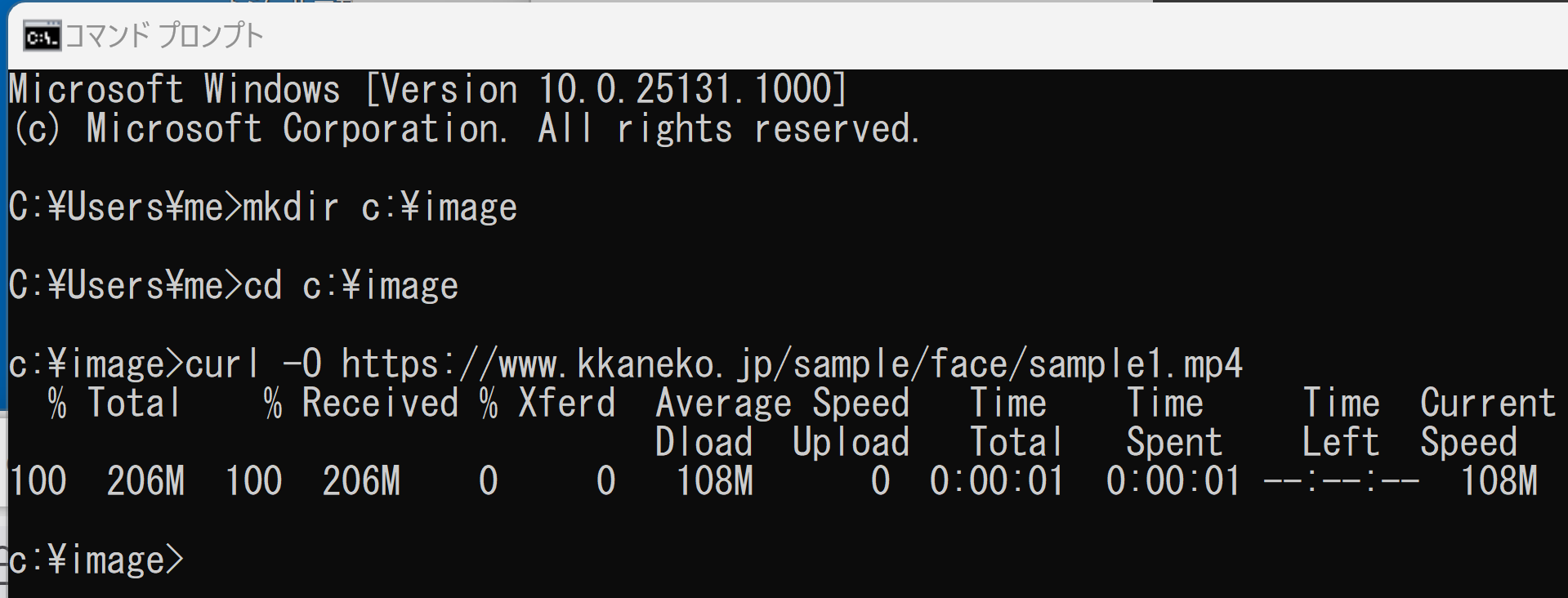
-
py -3.7 で,Python プログラムを実行する
Windows でのプログラムを下に示す.Ubuntu でも同様のプログラムになる.
OpenCV による動画表示を行う.
「FACEIMAGEROOT + "sample1.mp4"」のところは、実際のファイル名に置き換えること
import cv2 import numpy as np from deepgaze.color_detection import RangeColorDetector #Firs image boundaries min_range = np.array([0, 48, 70], dtype = "uint8") #lower HSV boundary of skin color max_range = np.array([20, 150, 255], dtype = "uint8") #upper HSV boundary of skin color my_skin_detector = RangeColorDetector(min_range, max_range) #Define the detector object FACEIMAGEROOT="c:/image/" v = cv2.VideoCapture(FACEIMAGEROOT + "sample1.mp4") while(v.isOpened()): r, f = v.read() if ( r == False ): break f = f[0:885, 0:773, 0:3] image_filtered = my_skin_detector.returnFiltered(f, morph_opening=False, blur=False, kernel_size=3, iterations=1) cv2.imshow("", image_filtered) # Press Q to exit if cv2.waitKey(1) & 0xFF == ord('q'): break v.release() cv2.destroyAllWindows()
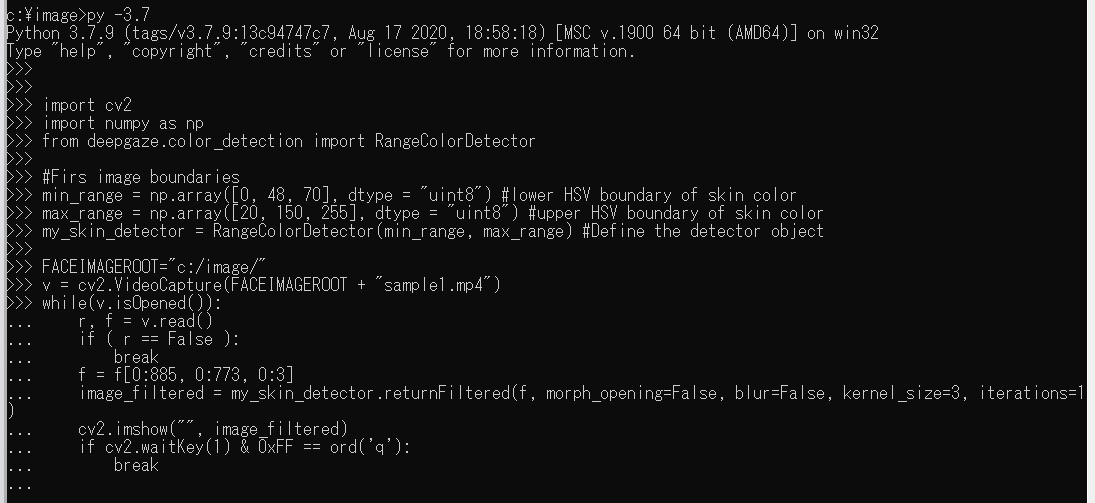
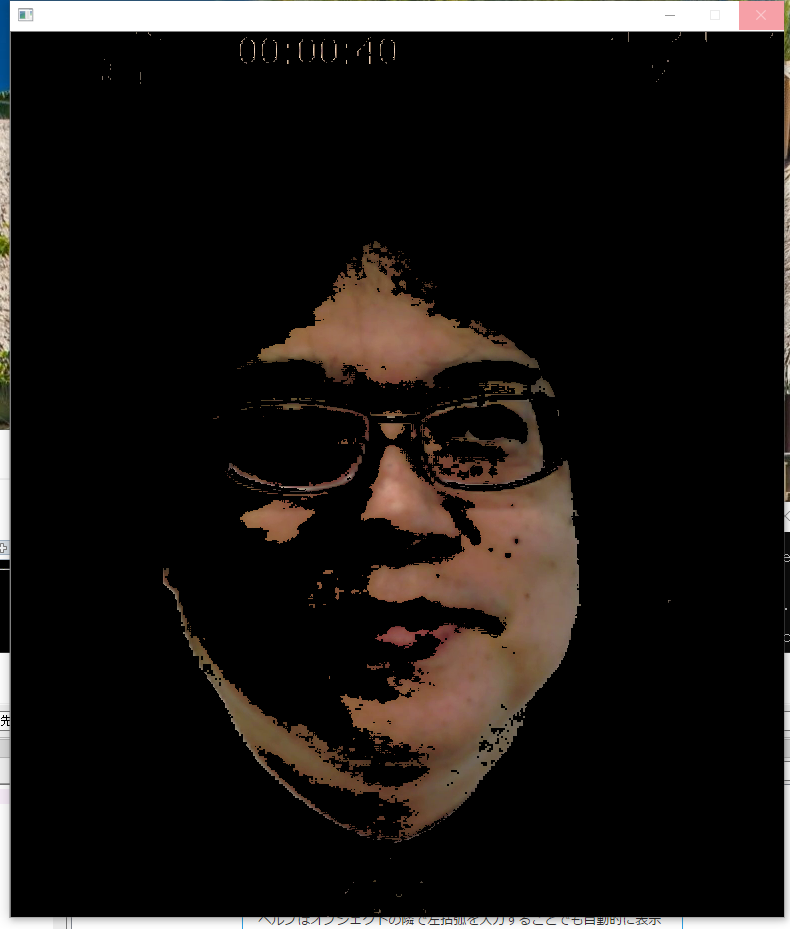
- C:\face-image のような作業用のディレクトリ(フォルダ)を作る
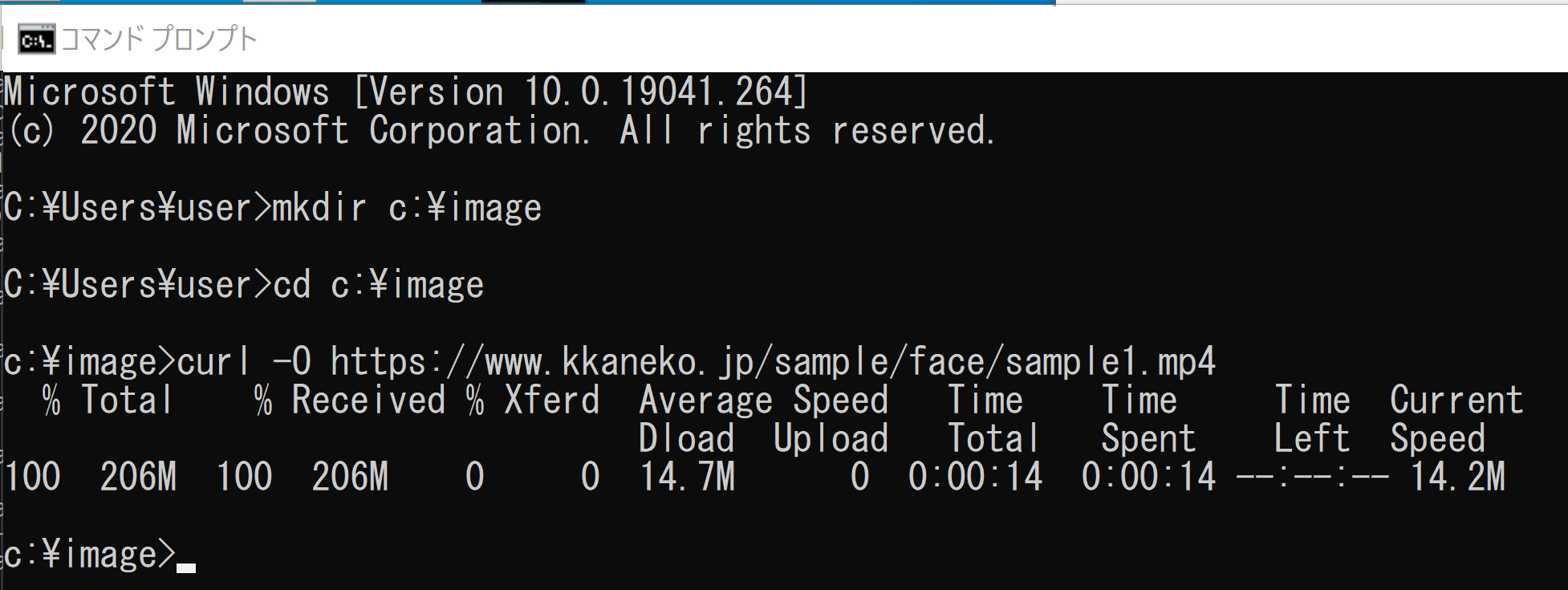
- 顔写真のデータを、先ほど作成した「作業用のディレクトリ(フォルダ)」に入れる
Webブラウザを使い、次の画像を「名前を付けて画像を保存」。 ファイル名は「126.png」とする。 「作業用のディレクトリ(フォルダ)」に保存する

次の画像も、「名前を付けて画像を保存」。 ファイル名は「127.png」とする。 「作業用のディレクトリ(フォルダ)」に保存する

次のようになる
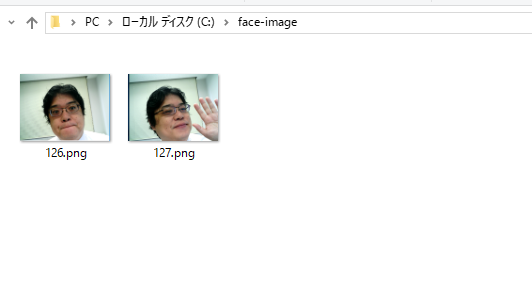
- サンプルプログラム
Web ブラウザで、 https://github.com/mpatacchiola/deepgaze/blob/master/examples/ex_skin_detection_images/ex_skin_detection_images.py を開く
- ここに掲載されているプログラムをコピー
- Windows のメモ帳を開き, 丸ごと、貼り付け

- このファイルの中の画像ファイル名を書き換え(2か所).
c:/image/126.png, c:/image/126-filtered.png,

- 後半部分は削除
- メモ帳で、ファイルを「名前を付けて保存」する。
このとき、ファイル名は、skin.py のようなファイル名で保存(拡張子は「.py」)
「作業用のディレクトリ(フォルダ)」である C:\face-image に保存する
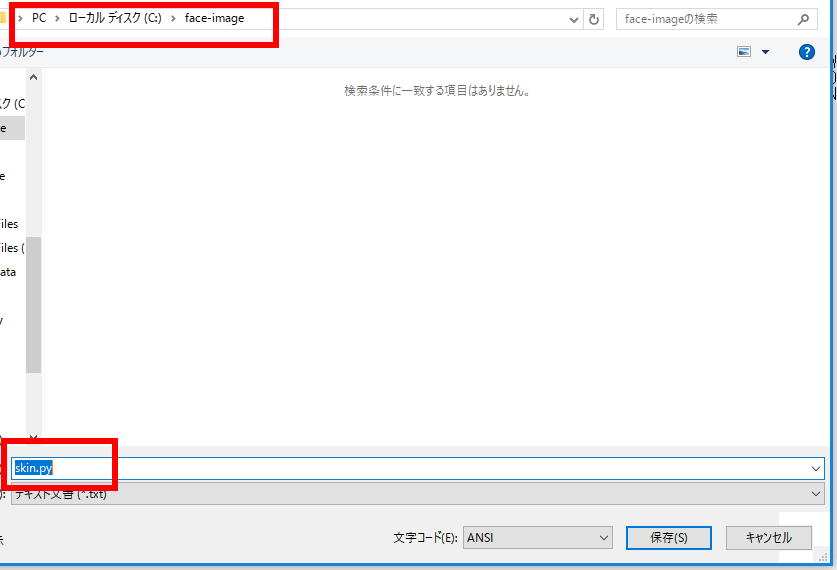
- メモ帳を閉じる
- Windows のコマンドプロンプトを開く
- 次のように実行
先ほど名前を付けて保存したときのファイル名を使う
cd C:\face-image python skin.py

- 結果の確認
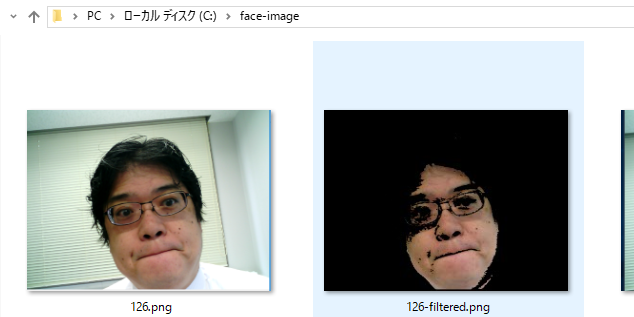
- Windows では,コマンドプロンプトを実行.
- 作業用のディレクトリ(フォルダ)として,c:\imageを作り,
sample1.mp4 を,c:\image の下にダウンロード
mkdir c:\image cd c:\image curl -O https://www.kkaneko.jp/sample/face/sample1.mp4

-
py -3.7 で,Python プログラムを実行する
Windows でのプログラムを下に示す.Ubuntu でも同様のプログラムになる.
OpenCV による動画表示を行う.
「FACEIMAGEROOT + "sample1.mp4"」のところは、実際のファイル名に置き換えること
import numpy as np import cv2 from deepgaze.saliency_map import FasaSaliencyMapping # Using OpenCV the resolution of the webcam is set to these values. # You must check which resolution your webcam support and adjust the values in accordance. RESOLUTION_WIDTH = 320 RESOLUTION_HEIGHT = 180 FACEIMAGEROOT="c:/image/" v = cv2.VideoCapture(FACEIMAGEROOT + "sample1.mp4") # Create the main window and move it cv2.namedWindow('Video') # Obtaining the CAM dimension w = int(v.get(3)) h = int(v.get(4)) # Defining the FASA object using the camera resolution my_map = FasaSaliencyMapping(h, w) while True: # Capture frame-by-frame r, f = v.read() if ( r == False ): break image_salient = my_map.returnMask(f, tot_bins=8, format='BGR2LAB') cv2.imshow("", image_salient) # Press Q to exit if cv2.waitKey(1) & 0xFF == ord('q'): break v.release() cv2.destroyAllWindows()
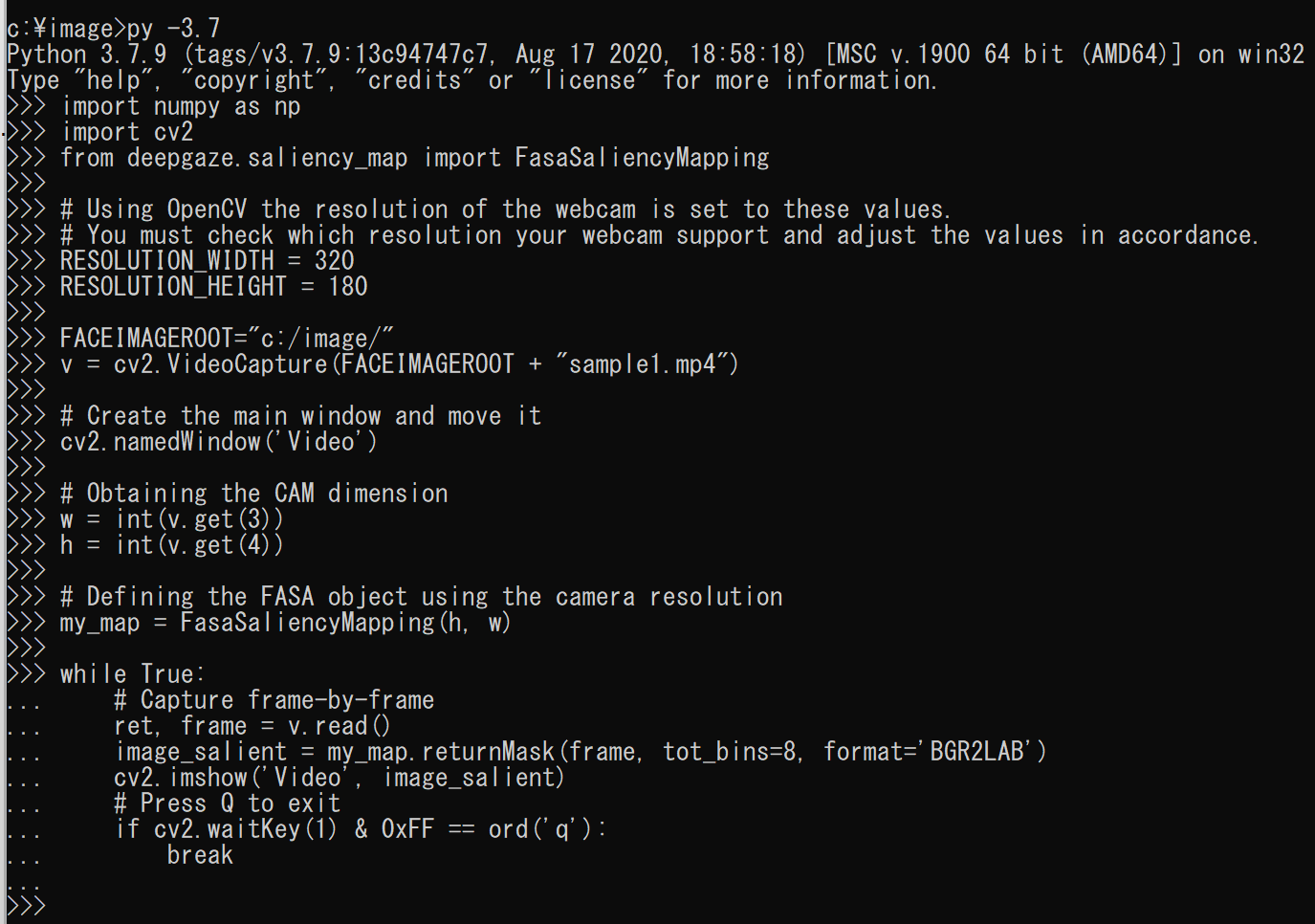
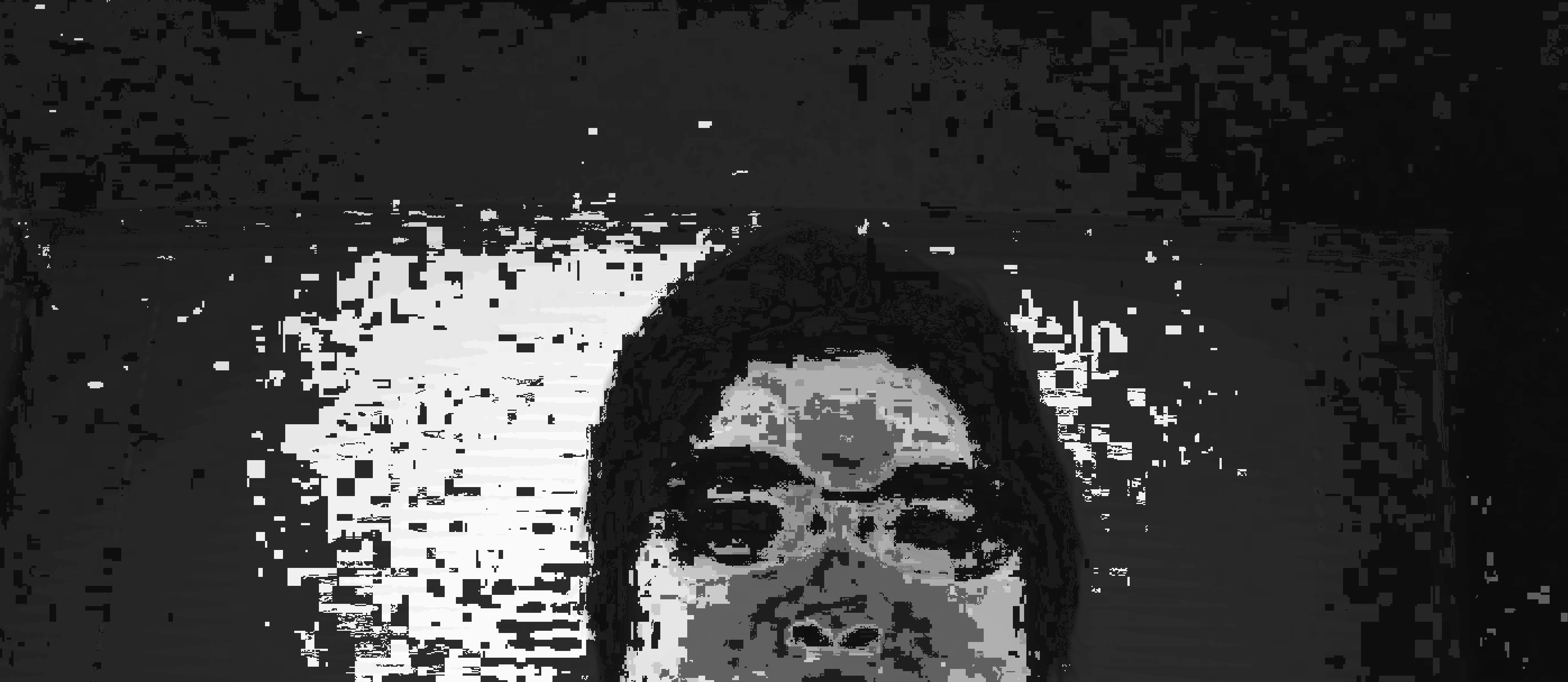
- Windows で,コマンドプロンプトを管理者として実行.
-
py -3.7 で,Python プログラムを実行する
OpenCV による動画表示を行う.
import numpy as np import cv2 from deepgaze.saliency_map import FasaSaliencyMapping # Using OpenCV the resolution of the webcam is set to these values. # You must check which resolution your webcam support and adjust the values in accordance. RESOLUTION_WIDTH = 320 RESOLUTION_HEIGHT = 180 # Open the video stream and set the webcam resolution. # It may give problem if your webcam does not support the particular resolution used. video_capture = cv2.VideoCapture(0) # Create the main window and move it cv2.namedWindow('Video') # Obtaining the CAM dimension cam_w = int(video_capture.get(3)) cam_h = int(video_capture.get(4)) # Defining the FASA object using the camera resolution my_map = FasaSaliencyMapping(cam_h, cam_w) while True: # Capture frame-by-frame r, f = video_capture.read() image_salient = my_map.returnMask(f, tot_bins=8, format='BGR2LAB') cv2.imshow("", image_salient) # Press Q to exit if cv2.waitKey(1) & 0xFF == ord('q'): break v.release() cv2.destroyAllWindows()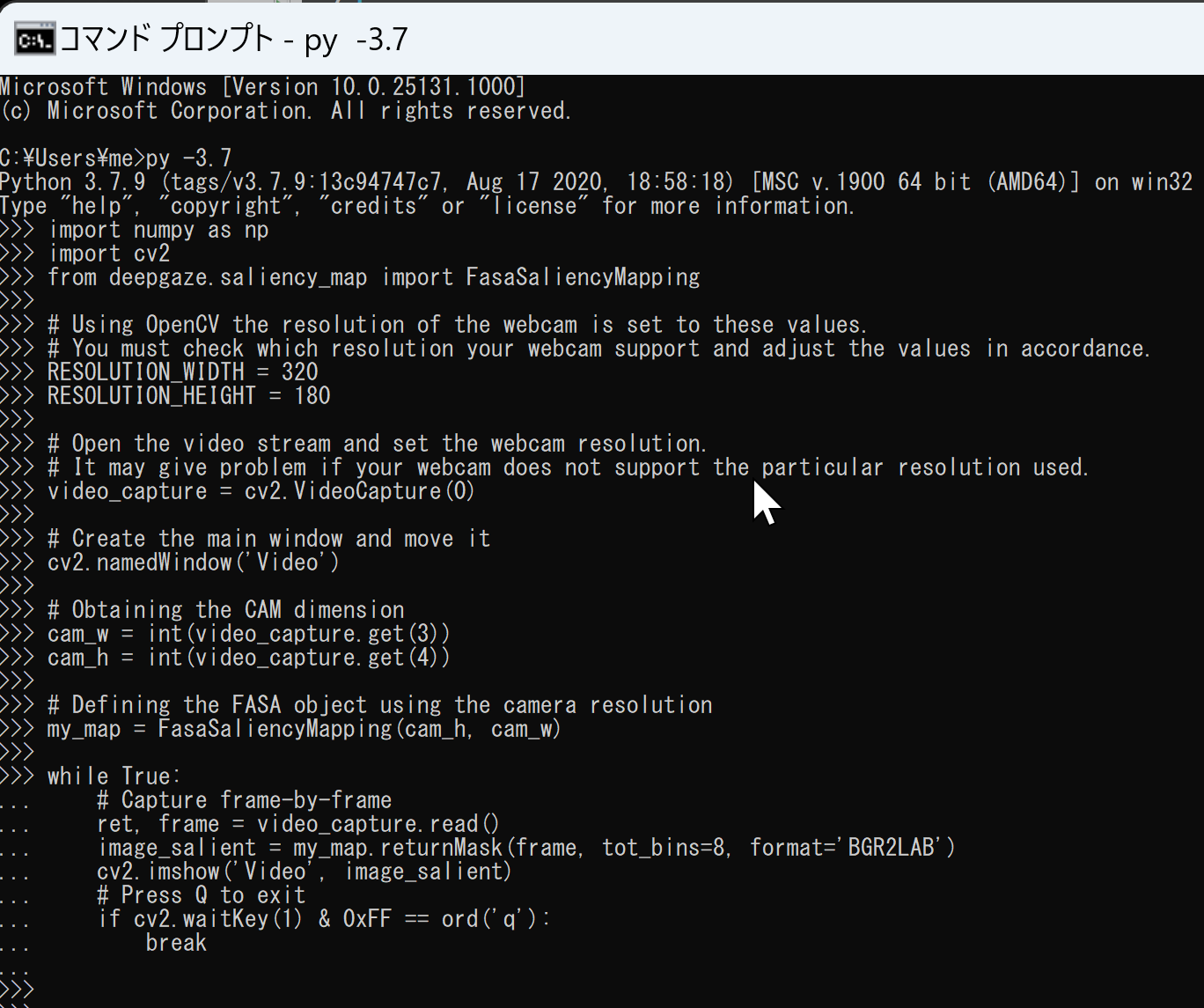
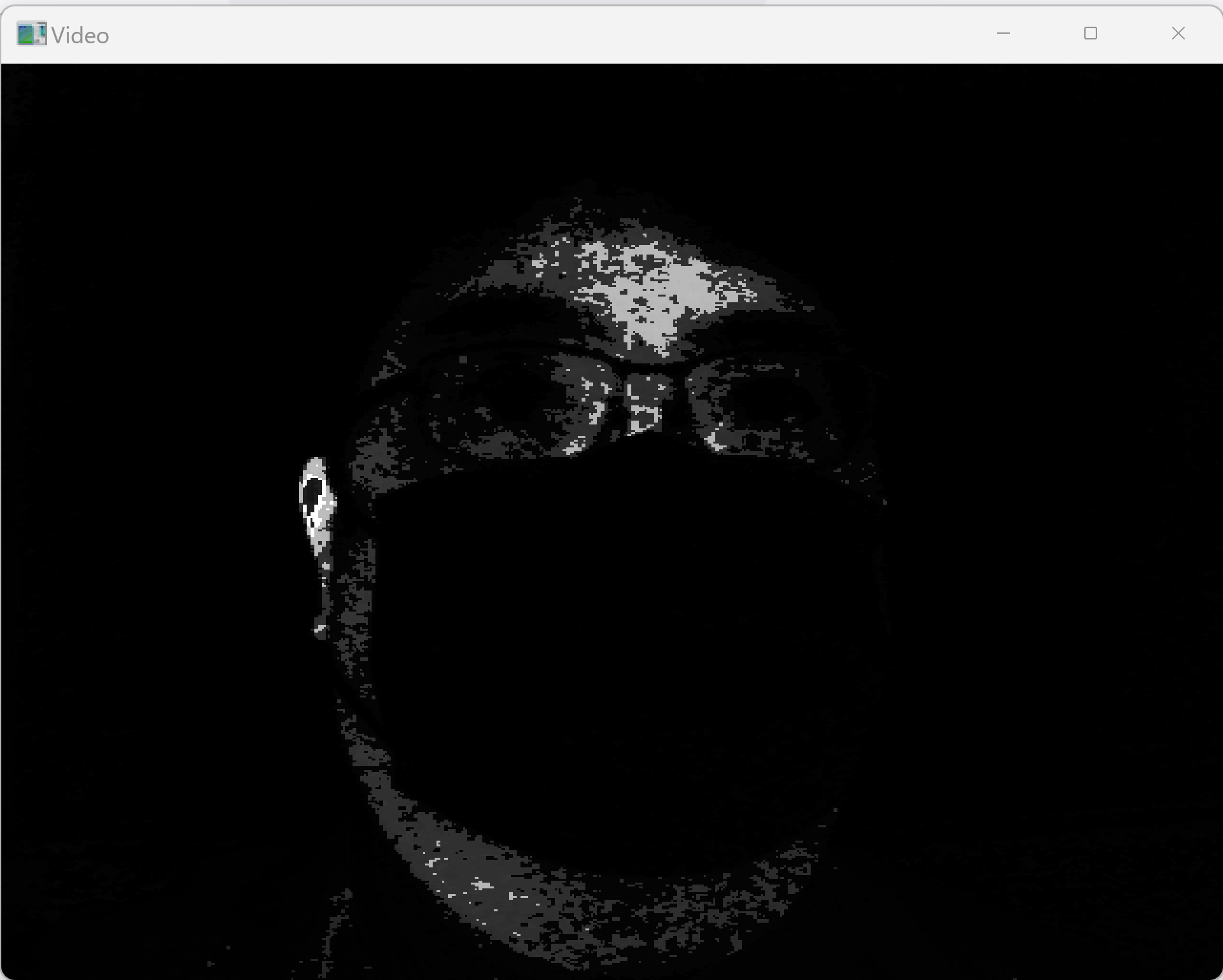
NVIDIA CUDA ツールキット 10.0 のインストール(Windows 上)
NVIDIA CUDA ツールキットのインストール時の注意点
NVIDIAのGPUを使用して並列計算を行うためのツールセット
主な機能: GPU を利用した並列処理,GPU のメモリ管理,C++をベースとした拡張言語とAPIとライブラリ
【NVIDIA CUDA ツールキットの動作に必要なもの】
【Windows でインストールするときの注意点】
【関連する外部ページ】
【関連項目】 NVIDIA CUDA ツールキット, NVIDIA CUDA ツールキット 12.6 のインストール(Windows 上), NVIDIA CUDA ツールキット 11.8 のインストール(Windows 上)
TensorFlow 1.15.5 が必要とする NVIDIA CUDA ツールキットと NVIDIA cuDNN のバージョンの確認
TensorFlow 1.15.5 を動かすために,NVIDIA CUDA ツールキット 10.0,NVIDIA cuDNN 7.6.5 を使う.
(10.2, 10.1 は不可.実際に試みて検証済み).
NVIDIA CUDA ツールキット 10.0,NVIDIA cuDNN 7.6.5 の根拠: cudart64_100.dll, cudnn64_7.dll が必要
インストール手順
NVIDIA cuDNN 7.6.5 のインストール
インストールするNVIDIA cuDNN のバージョンは 7.6.5 for CUDA 10.0
NVIDIA cuDNN
NVIDIA cuDNN は,NVIDIA CUDA ツールキット上で動作する、高性能なディープラーニング用ライブラリです.畳み込みニューラルネットワーク (CNN) やリカレントニューラルネットワーク (RNN) など,さまざまなディープラーニングモデルのトレーニングと推論を高速化します.
【cuDNN利用時の注意点: zlibwapi.dll エラー】
Windows環境でcuDNNを利用するアプリケーションを実行した際に、「Could not locate zlibwapi.dll. Please make sure it is in your library path!」というエラーが表示されることがあります。これは、cuDNNの一部の機能が圧縮ライブラリである zlib に依存しているためです。このエラーが発生した場合は、後述する手順で ZLIB DLL をインストールする必要があります。
【関連する外部ページ】
NVIDIA cuDNN のインストール(Windows 上)の概要
NVIDIA cuDNN のダウンロードとインストールの手順
インストール後に行う環境変数の設定
「NVIDIA cuDNN をインストールしたディレクトリ」をもとに環境変数を設定する.
「NVIDIA cuDNN をインストールしたディレクトリ」が C:\Program Files\NVIDIA GPU Computing Toolkit\CUDA\v10.0 の場合には,次のように設定する.
パスの確認
次の操作により,cudnn64_7.dll にパスが通っていることを確認する
Windows のコマンドプロンプトを開き,次のコマンドを実行する.エラーメッセージが出ないことを確認.
where cudnn64_7.dll

前準備
Gitのインストール
管理者権限でコマンドプロンプトを起動(手順:Windowsキーまたはスタートメニュー > cmd と入力 > 右クリック > 「管理者として実行」)し、以下を実行する。管理者権限は、wingetの--scope machineオプションでシステム全体にソフトウェアをインストールするために必要となる。
REM Git をシステム領域にインストール
winget install --scope machine --id Git.Git -e --silent --accept-source-agreements --accept-package-agreements
REM Git のパス設定
set "GIT_PATH=C:\Program Files\Git\cmd"
if exist "%GIT_PATH%" (
echo "%PATH%" | find /i "%GIT_PATH%" >nul
if errorlevel 1 setx PATH "%PATH%;%GIT_PATH%" /M >nul
)
CMake のインストール
CMake の公式ダウンロードページ: https://cmake.org/download/
Python 3.7 64 ビット版のインストール,pip と setuptools の更新,Python 開発環境のインストール(Windows 上)
① Python 3.7 64 ビット版のインストール(Windows 上)
【Python のインストールでの注意点】
【Python 3.7 のインストール手順の詳細(別ページ) 】 Windows での Python 3.7 のインストール: 別ページ »で説明
【Python の公式ページ】 https://www.python.org/
【インストール手順の概要】
② pip と setuptools の更新(Windows 上)
③ Python 開発環境として,Python の隔離された環境に,Python コンソール(Jupyter Qt Console), Jupyter ノートブック (Jupyter Notebook), Jupyter Lab, Nteract をインストール
Visual Studio Community 2017 のインストール
NVIDIA CUDA 10.0 は Visual Studio Commnity 2017, 2015, 2013, 2012 と連携して動く機能がある.
NVIDIA CUDA 10.0 のインストールの前に, Visual Studio Commnity 2017 のインストールを行う.
Visual Studio Commnity 2017 のインストールは, https://visualstudio.microsoft.com/ja/vs/older-downloads/ で「2017」を選び,「ダウンロード」をクリック. その後表示されるダウンロードの画面で, 「Visual Studio Commnity 2017」を選ぶ. インストール時には「C++ によるデスクトップ開発」をチェックしてインストールする.
NVIDIA ドライバのインストール(Windows 上)
NVIDIA ドライバとは
NVIDIA ドライバは,NVIDIA製GPUをWindowsシステム上で適切に動作させるための基盤となるソフトウェアです.このドライバをインストールすることにより,GPUの性能を最大限に引き出し,グラフィックス処理はもちろん,CUDAを利用したAI関連アプリケーションなどの計算速度を向上させることが期待できます.
ドライバは通常、NVIDIA公式サイトからダウンロードするか、NVIDIA GeForce Experienceソフトウェアを通じてインストール・更新します。
公式サイト: https://www.nvidia.co.jp/Download/index.aspx?lang=jp
【サイト内の関連ページ】
NVIDIA CUDA ツールキット 10.0 のインストール(Windows 上)
NVIDIA CUDA ツールキットのインストール時の注意点
NVIDIAのGPUを使用して並列計算を行うためのツールセット
主な機能: GPU を利用した並列処理,GPU のメモリ管理,C++をベースとした拡張言語とAPIとライブラリ
【NVIDIA CUDA ツールキットの動作に必要なもの】
【Windows でインストールするときの注意点】
【関連する外部ページ】
【関連項目】 NVIDIA CUDA ツールキット, NVIDIA CUDA ツールキット 12.6 のインストール(Windows 上), NVIDIA CUDA ツールキット 11.8 のインストール(Windows 上)
TensorFlow 1.15.5 が必要とする NVIDIA CUDA ツールキットと NVIDIA cuDNN のバージョンの確認
TensorFlow 1.15.5 を動かすために,NVIDIA CUDA ツールキット 10.0,NVIDIA cuDNN 7.6.5 を使う.
(10.2, 10.1 は不可.実際に試みて検証済み).
NVIDIA CUDA ツールキット 10.0,NVIDIA cuDNN 7.6.5 の根拠: cudart64_100.dll, cudnn64_7.dll が必要
インストール手順
NVIDIA cuDNN 7.6.5 のインストール
インストールするNVIDIA cuDNN のバージョンは 7.6.5 for CUDA 10.0
NVIDIA cuDNN
NVIDIA cuDNN は,NVIDIA CUDA ツールキット上で動作する、高性能なディープラーニング用ライブラリです.畳み込みニューラルネットワーク (CNN) やリカレントニューラルネットワーク (RNN) など,さまざまなディープラーニングモデルのトレーニングと推論を高速化します.
【cuDNN利用時の注意点: zlibwapi.dll エラー】
Windows環境でcuDNNを利用するアプリケーションを実行した際に、「Could not locate zlibwapi.dll. Please make sure it is in your library path!」というエラーが表示されることがあります。これは、cuDNNの一部の機能が圧縮ライブラリである zlib に依存しているためです。このエラーが発生した場合は、後述する手順で ZLIB DLL をインストールする必要があります。
【関連する外部ページ】
NVIDIA cuDNN のインストール(Windows 上)の概要
NVIDIA cuDNN のダウンロードとインストールの手順
インストール後に行う環境変数の設定
「NVIDIA cuDNN をインストールしたディレクトリ」をもとに環境変数を設定する.
「NVIDIA cuDNN をインストールしたディレクトリ」が C:\Program Files\NVIDIA GPU Computing Toolkit\CUDA\v10.0 の場合には,次のように設定する.
パスの確認
次の操作により,cudnn64_7.dll にパスが通っていることを確認する
Windows のコマンドプロンプトを開き,次のコマンドを実行する.エラーメッセージが出ないことを確認.
where cudnn64_7.dll

TensorFlow 1.15.5, Keras 2.3.1 のインストール
コマンドプロンプトを管理者として実行し,次のコマンドを実行
C:\venv\py37\Scripts\activate.bat
python -m pip uninstall -y tensorflow tensorflow-cpu tensorflow-gpu tensorflow-intel tensorflow-text tensorflow-estimator tf-models-official tf_slim tensorflow_datasets tensorflow-hub keras keras-tuner keras-visualizer scipy pandas matplotlib
# TensorFlow 1.15.5 のため numpy, protobuf の古いバージョンを使用.エラーが出にくいと考えられる numpy 1.16.2, protobuf 3.19.4 を使用
python -m pip install -U numpy==1.16.2 protobuf==3.19.4 tensorflow-gpu==1.15.5 keras==2.3.1 scipy==1.5.4
mpatacchiola/DeepGaze のインストール
Windows での手順を下に示す.Ubuntu でも同様の手順になる.
このページで説明のために使用するビデオ、写真
必要であればダウンロードして使ってください.
mpatacchiola/DeepGaze を用いて肌色領域の抜き出し
動画ファイルで動かしてみる
パソコンの USB カメラで動かしてみる
Python プログラムを実行する
「v = cv2.VideoCapture(0) 」は、USB カメラを使うためのもの。他の部分は、上のプログラムと同じ。
import cv2
import numpy as np
from deepgaze.color_detection import RangeColorDetector
#Firs image boundaries
min_range = np.array([0, 48, 70], dtype = "uint8") #lower HSV boundary of skin color
max_range = np.array([20, 150, 255], dtype = "uint8") #upper HSV boundary of skin color
my_skin_detector = RangeColorDetector(min_range, max_range) #Define the detector object
v = cv2.VideoCapture(0)
while(v.isOpened()):
r, f = v.read()
if ( r == False ):
break
f = f[0:885, 0:773, 0:3]
image_filtered = my_skin_detector.returnFiltered(f, morph_opening=False, blur=False, kernel_size=3, iterations=1)
cv2.imshow("", image_filtered)
# Press Q to exit
if cv2.waitKey(1) & 0xFF == ord('q'):
break
v.release()
cv2.destroyAllWindows()
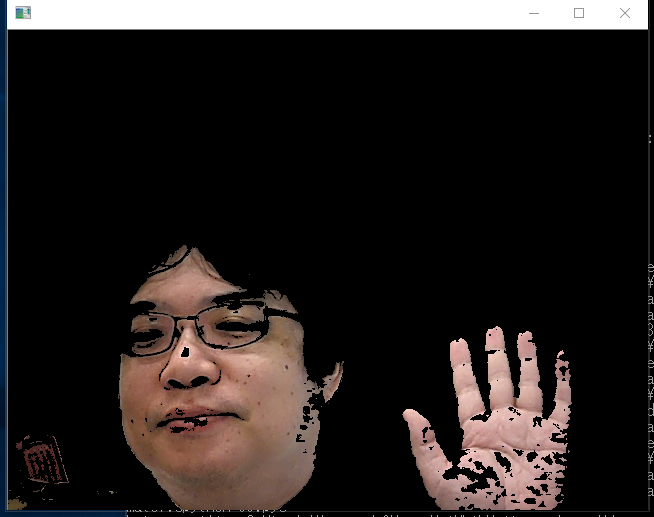
パソコンの USB カメラで動かし,結果を動画像ファイルに保存
Python プログラムを実行する
Windows でのプログラムを下に示す.Ubuntu でも同様のプログラムになる.
「out = cv2.VideoWriter('C:/image/output.avi', fourcc, 20.0, (640, 480), True) 」の「True」は、カラーという意味
import cv2
import numpy as np
from deepgaze.color_detection import RangeColorDetector
#Firs image boundaries
min_range = np.array([0, 48, 70], dtype = "uint8") #lower HSV boundary of skin color
max_range = np.array([20, 150, 255], dtype = "uint8") #upper HSV boundary of skin color
my_skin_detector = RangeColorDetector(min_range, max_range) #Define the detector object
v = cv2.VideoCapture(0)
fourcc = cv2.VideoWriter_fourcc(*'XVID')
FACEIMAGEROOT="c:/image/"
out = cv2.VideoWriter(FACEIMAGEROOT + 'output.avi', fourcc, 20.0, (640, 480), True)
while(v.isOpened()):
r, f = v.read()
if ( r == False ):
break
f = f[0:885, 0:773, 0:3]
image_filtered = my_skin_detector.returnFiltered(f, morph_opening=False, blur=False, kernel_size=3, iterations=1)
cv2.imshow("", image_filtered)
out.write(image_filtered)
# Press Q to exit
if cv2.waitKey(1) & 0xFF == ord('q'):
break
v.release()
out.release()
cv2.destroyAllWindows()
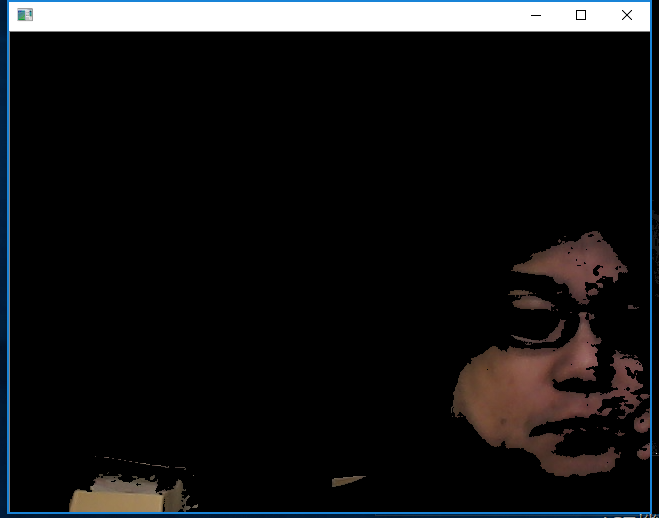
付属のサンプルプログラムを動かしてみる
もう1つの画像で確認
skin.py の中の画像ファイル名を 126 から 127 に書き換えて、python skin.py をもう一度実行。次のような結果になる
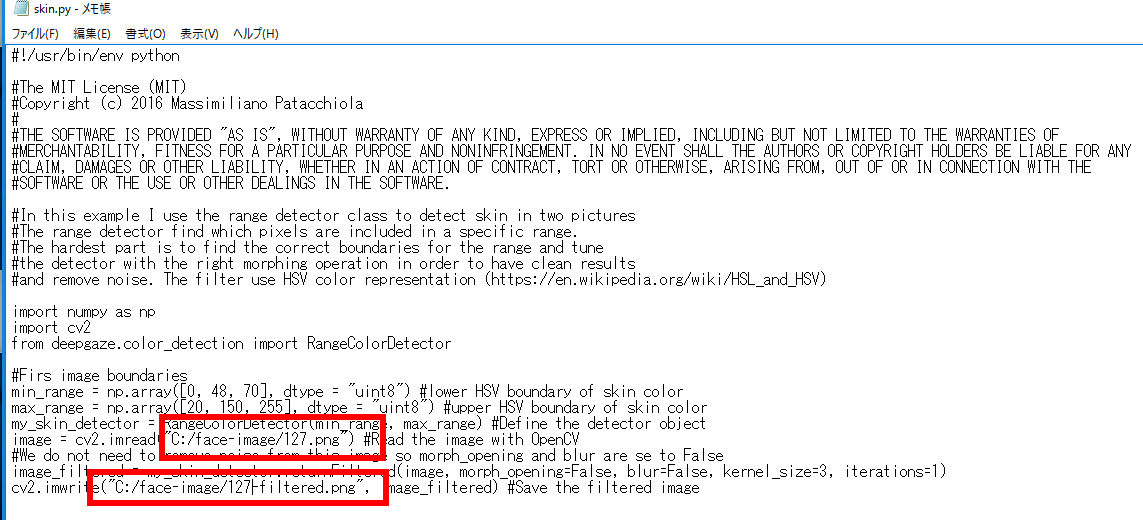


mpatacchiola/DeepGaze を用いて saliency の検出
動画ファイルで動かしてみる
ビデオカメラで動かしてみる
Windows での手順を下に示す.Ubuntu でも同様の手順になる.
![[kaneko lab.]](https://www.kkaneko.jp/info/logo_png.png)